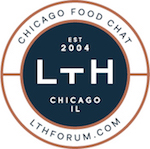Eating in Tokyo, Osaka, and Kyoto
Eating in Tokyo, Osaka, and Kyoto
-
-
-
-
-
Eating in Tokyo, Osaka, and Kyoto
-
Post #1 - August 29th, 2012, 11:25 amFor my honeymoon (yay), my new bride and I will be spending 7 days in Tokyo then 7 days in Osaka (with train trips into Kyoto).
I read the previously thread about visiting Japan (circa 2010) but am hoping that the lth world can offer me even greater guidance.
In Tokyo we'll be staying at a hotel atop Shinjuku Station (and yes, we know it's the busiest train station in the world) BUT that means that we have access to the entire city at our fingertips.
In Osaka we'll be staying in the Nanba area.
We eat almost everything. I don't like mayo and she doesn't like things that are too spicy but that's about it. Fish, noodles, beef, chicken, pork, veggies, raw, cooked, boiled, grilled, on the street, at a table, I will eat green eggs and ham oh, I will eat them, Sam I am.
PLEASE HELP!
-
-
Post #2 - August 29th, 2012, 8:00 pmI recently spent some time in Tokyo and Kyoto. Unfortunately, I couldn't tell you the names of any places. We relied primarily on the concierge to direct us to local hangouts. We never had a bad meal there. Though we never had a cheap meal either. Count on $150-$200 for two at a mid-priced reasonably nice place. We ate breakfast in our hotel rooms of things we got at 7-11 or one of the department stores. All the department stores have huge food courts and groceries in them (there are three major dept stores near Shinjuku). Not cheap, but cheaper than restaurants for sure. I recall paying $8 for an Asian pear. My son wanted some cherries, but those were about $20/lb so I said "no dice."
Sushi is actually reasonably priced there relative to other things. Yakatori bars would be good, but not with our kids. Tonkatsu is reasonably priced. We had a great meal at an eel place south of Tokyo station along the tracks somewhere.
We had a nice meal near Nanzenji Temple in Kyoto (restaurant name was Nanzenji Junsei). All tofu.
Get sushi at one of the places in the big fish market in Tokyo. There's an upscale pizza place on one of the top floors of Kyoto Station if you are sick of Japanese food.
Sorry this isn't more helpful, but really, you can't go wrong if you go where the locals go.i used to milk cows
-
-
Post #3 - August 31st, 2012, 12:20 pmThanks for the suggestions teatty. I'm definitely down to follow the locals but not speaking Japanese I worry that an off the beaten path restaurant will lead to me pointing and smiling like an imbecile.
I was hoping someone would know some local spots where I could be reasonably ensured that they spoke a level of English that didn't leave me acting like a jerk off tourist.
But since you just went let me ask you, how easily or not can a person who doesn't speak or read Japanese navigate and eat?
-
-
Post #4 - August 31st, 2012, 3:23 pmWe went to Tokyo and Kyoto in May! I especially liked the food area at Tokyo Station (if you are taking the shinkansen to Kyoto) called GrandSta. The pork tonkatsu and egg sandwich was so good I ate it 3 days in a row!
In Tokyo, we went to Sushi Dai (at 6am there was an hour's wait). But we went back to the fried seafood place next door twice for very reasonably priced, fresh and large portions of fried fish/giant prawn/scallops and rice.
Also in Kyoto we stayed across the street from Kyoto Station and the department store there has a supermarket and food stands. Try going around 7-7:30 and you will find that the fruit, sushi, sashimi will be discounted. We got some cut fruits and a very good sashimi platter for a very reasonable (for Japan) price!
-
-
Post #5 - August 31st, 2012, 3:33 pmeggman2814 wrote:teatty
I'm SO stealing this Last edited by zoid on August 31st, 2012, 4:50 pm, edited 1 time in total.
Last edited by zoid on August 31st, 2012, 4:50 pm, edited 1 time in total.
-
-
Post #6 - August 31st, 2012, 4:37 pmeggman2814 wrote:But since you just went let me ask you, how easily or not can a person who doesn't speak or read Japanese navigate and eat?
In all of my travels to Japan, my wife and I have never had a problem finding a spot to eat. Unless we were meeting someone, we've never planned to scout out a particular restaurant. Just wander around and look where the locals are eating. Many restaurants have menus with photographs. Also check out the food halls (usually in the basement) of major department stores.
A good dining site for Japan - http://bento.com/tokyofood.htmlNever order barbecue in a place that also serves quiche - Lewis Grizzard
-
-
Post #7 - August 31st, 2012, 8:22 pmeggman2814 wrote: I'm definitely down to follow the locals but not speaking Japanese I worry that an off the beaten path restaurant will lead to me pointing and smiling like an imbecile.
But since you just went let me ask you, how easily or not can a person who doesn't speak or read Japanese navigate and eat?
OK. ALL of the menus are written in traditional Japanese characters. SOME of the menus have pictures that you can point to. Maybe 5% of the restaurants will have someone that can speak some level of English. The only thing you can possibly do is point like an imbecile. It is not like Europe at all. Thankfully you have two things going for you:
1) the Japanese are incredibly polite and will attempt to assist you the best they can
2) like I mentioned before, there are no bad restaurants in Japan, at least none we ate ate. The culture is very different: mediocrity is not accepted at any level, anywhere.
Don't worry, you'll be fine.i used to milk cows
-
-
Post #8 - September 1st, 2012, 5:58 pmeggman2814 wrote:Thanks for the suggestions teatty. I'm definitely down to follow the locals but not speaking Japanese I worry that an off the beaten path restaurant will lead to me pointing and smiling like an imbecile.
I was hoping someone would know some local spots where I could be reasonably ensured that they spoke a level of English that didn't leave me acting like a jerk off tourist.
But since you just went let me ask you, how easily or not can a person who doesn't speak or read Japanese navigate and eat?
Depending on your hotel, you could ask the concierge to translate a copy of the menu for you before you head to the restaurant. When I was there two years ago, we stayed at the Shangri-La. I'd asked the concierge to make reservations for us. Not only did they give us reservations, but for each reservation they gave us:
1. The name, address, phone number and directions to the restaurant in both English & Japanese. (By car & by subway)
2. A street map showing the restaurant's location.
3. A photograph of the front door so we'd recognize it.
4. A copy of the menu with English translations for each item for restaurants where there might not be English-speaking staff.
-
-
Post #9 - September 2nd, 2012, 6:07 pmzoid wrote:eggman2814 wrote:teatty
I'm SO stealing this
Glad you liked it.
Thanks to all thus far. I'm just anxious, nervous, excited, other words that means those things, etc. I want the best possible food experience and don't want to insult someone else's culture. And we can't all have fixers like Tony Bourdain.
-
-
Post #10 - September 2nd, 2012, 7:34 pmchgoeditor and I both wrote lengthy summaries here: viewtopic.php?f=15&t=28349&hilit=tokyo. Mine's from, you know, April of this year...
We ate very well from all ends: high, middle, and low; it is entirely possible to eat amazingly here without spending much. Frankly, I'd focus on the very top--Ryugin, a three-star sushi temple--and then do ramen and other homey simple things for lunch, thereby enabling you to get a full range of the Tokyo experience. The train station food courts are worth visiting for the spectacle, but the food is nothing special; there is always a worthier ramen spot within walking distance of the station, you know.
My secret weapon was an iPad: load up the restaurant's location before you go and use the tracker to navigate your way there. Save for Birdland Ginza, it got us everywhere we needed to be.
-
-
Post #11 - September 2nd, 2012, 8:02 pmBTW something that might be useful... We rented a mobile wi-fi device for our trip. Around $100 for the week, and it allowed us to use our smartphones for Google Maps, surfing and whatnot. We could not find free public wifi easily and did not want to risk paying too much for roaming charges...
-
-
Post #12 - September 3rd, 2012, 6:10 amCrazyC wrote:BTW something that might be useful... We rented a mobile wi-fi device for our trip. Around $100 for the week, and it allowed us to use our smartphones for Google Maps, surfing and whatnot.
Yes. We did that also. Highly recommended.i used to milk cows
-
-
Post #13 - September 4th, 2012, 2:27 pmteatpuller wrote:CrazyC wrote:BTW something that might be useful... We rented a mobile wi-fi device for our trip. Around $100 for the week, and it allowed us to use our smartphones for Google Maps, surfing and whatnot.
Yes. We did that also. Highly recommended.
From what companies did you both rent your devices? Your regular wireless carrier? A Japanese company?
-
-
Post #14 - September 4th, 2012, 7:17 pmeggman2814 wrote:teatpuller wrote:CrazyC wrote:BTW something that might be useful... We rented a mobile wi-fi device for our trip. Around $100 for the week, and it allowed us to use our smartphones for Google Maps, surfing and whatnot.
Yes. We did that also. Highly recommended.
From what companies did you both rent your devices? Your regular wireless carrier? A Japanese company?
This is not an ad! We rented it from Global Advanced Communication
It was delivered to our hotel on the day we arrived and when we left, we dropped it off at the post office at Narita airport. Pretty convenient!
-
-
Post #15 - September 5th, 2012, 7:46 pmWe used this company: http://www.jcrcorp.com/mobile/mobile_re ... router.htm
no problems. Similar deal as above.i used to milk cows
-
-
Post #16 - September 5th, 2012, 9:51 pmAlso if you happen to have spend a night near Narita Airport, Edokko in Narita was really very good. When we ate there, we were the only non-Japanese people and managed to get by with a smattering of Japanese. They also have a picture book of their sets. We ended up chatting with our neighbors at the sushi bar who happened to be a truck driver in Japan, but had driven through the entire US, and his companion, a very VERY drunk man who kept telling Mike and me to get cracking on making babies...

All in all an excellent and entertaining night...
The Matsu set was 2,500 yen and but they did not charge us for the extra 2 akamutsu, 2 torigai, 1 uni and 1 toro pieces...

Edokko - Masu set by agashi, on Flickr
Edokko - Anago by agashi, on Flickr
Edokko - Raw Torigai by agashi, on Flickr
Edokko - Akamutsu by agashi, on Flickr
-
-
Post #17 - October 6th, 2012, 9:47 pmThanks for the wifi recommendations. We wouldn't have made it through Japan without it! Photos to soon follow
-
-
Post #18 - October 12th, 2013, 11:29 amI just returned from a my second trip to Japan - my second visit to Tokyo (first since a member of this forum), but my first trips to Osaka and Kyoto. I also visited Hiroshima, but just visited the Peace Memorial and Museum (very moving and absolutely worthy of a visit).
I'll have a series of posts, but in this one I'll focus a bit on Tsukiji fish market. We arrived in Tokyo on a Friday night and by the time we made it to our hotel in Tokyo, we were exhausted and were asleep by 9pm. Our plan though was to use this exhaustion to our benefit, wake up really early Saturday and head to Tsukiji market. The only problem is that Saturday is the busiest day at the market and we really didn't care enough to make it to the tuna auction, at least not to wake up at 3am or so to get there in time. We did get a peek, but that was about it.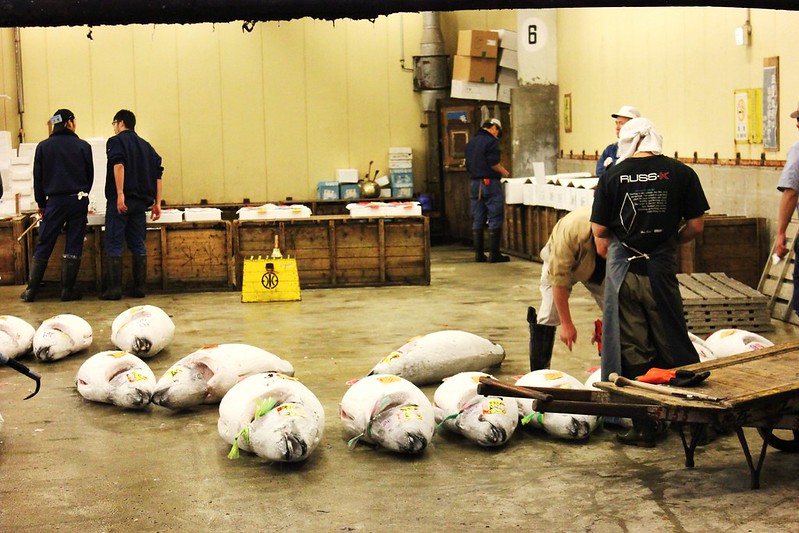
The market gets going early and controlled chaos is the best way to describe it. If you don't stay to the side of passageways, you're likely to be injured by several of the thousands of vehicles/lifts moving quickly through the market. The amount of traffic racing through and around the market is really unbelievable.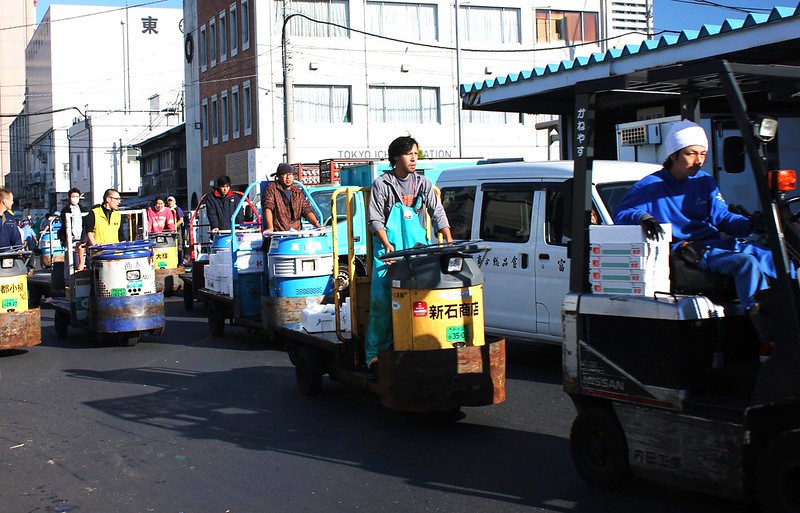
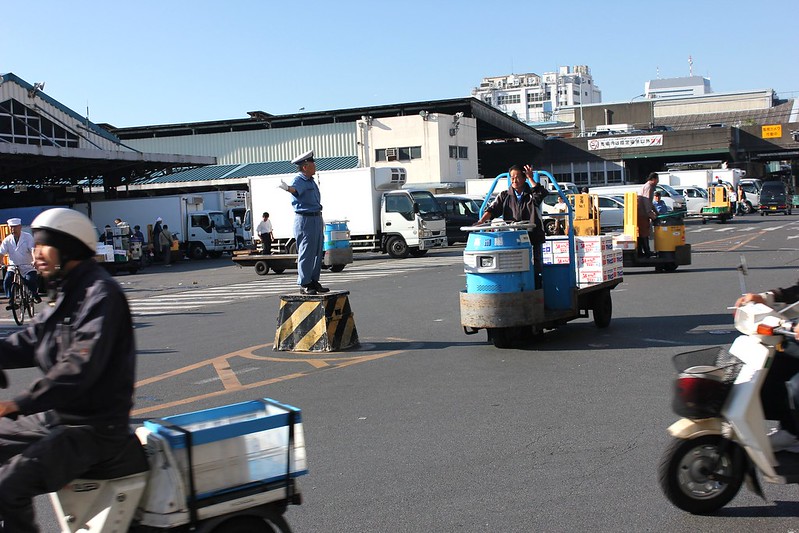
Directing traffic at Tsukiji market
It's so chaotic and large-scale that the term "market" just doesn't really help you understand Tsukiji - it's more like its own city. Fish is being moved throughout the market in scales so large as to be almost incomprehensible: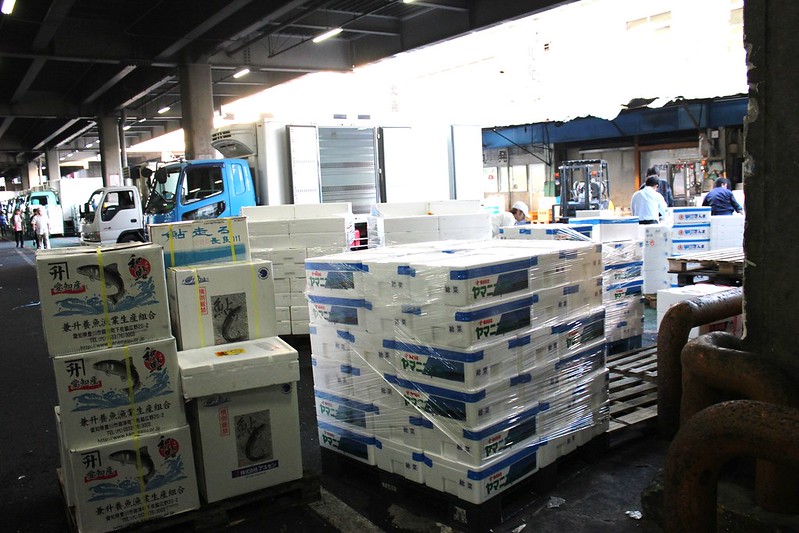
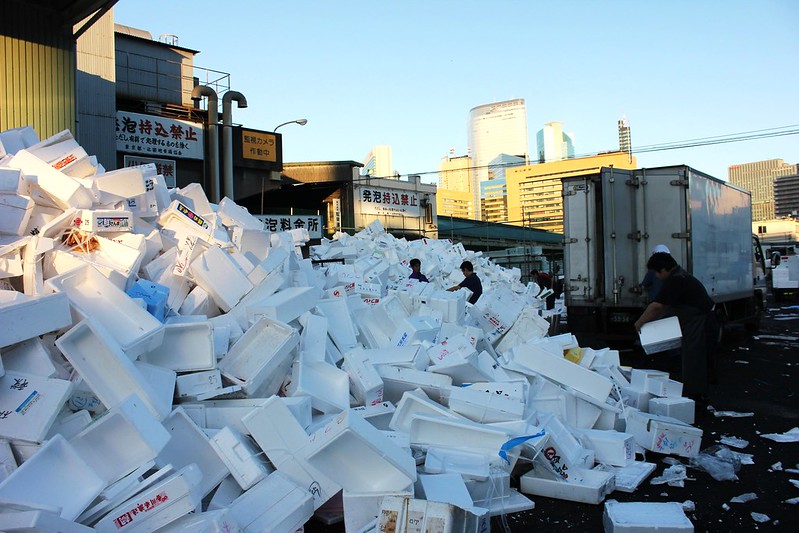
Although we didn't make it to the market in time to be admitted to the tuna auction (we were informed you really need to be there by 4am on a Saturday to ensure admittance), we did get there before 6am with the plan of going to Sushi Dai. Although I'm sure there are plenty of terrific places to enjoy sushi at Tsukiji, Sushi Dai and Daiwa Sushi (right next to one another) are the most popular choices. But even at 6am, the line for Sushi Dai was 3-hours long. We instead opted for the 1-hour long line at Daiwa Sushi: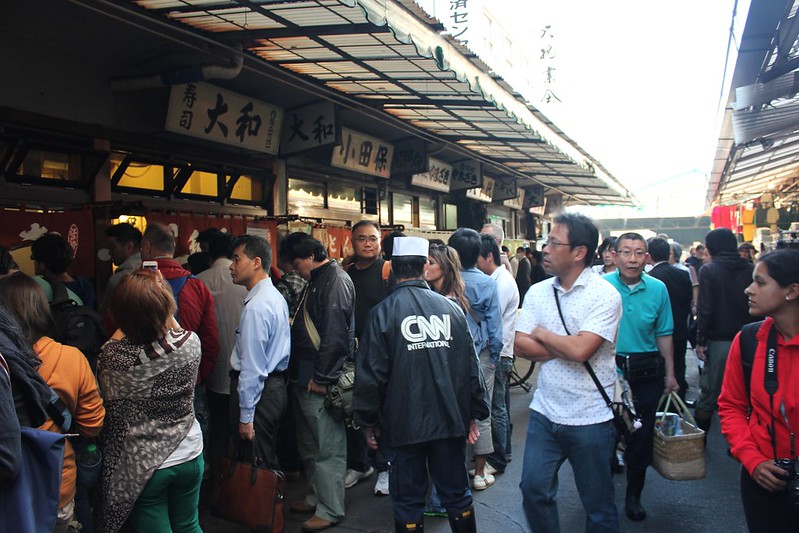
Daiwa is quite small, counter only, and not the place you go for a leisurely sushi meal. There's barely enough room between your back and the pathway for people to get by you.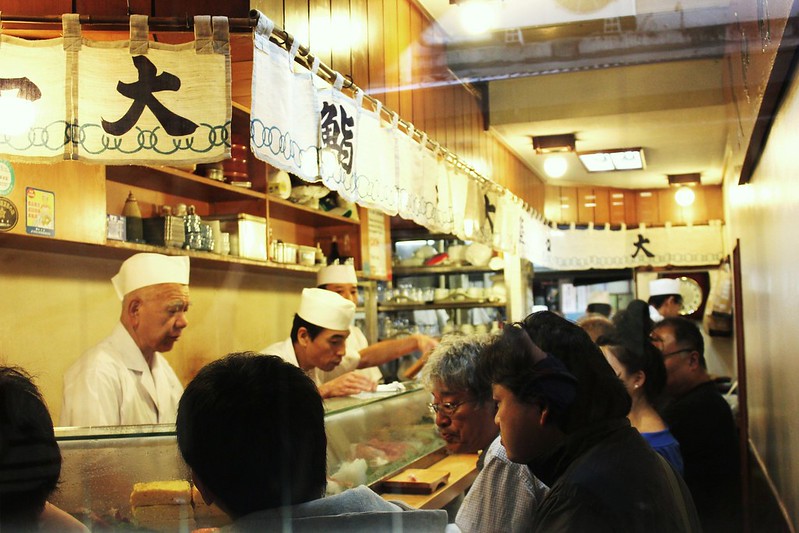
Interior of Daiwa Sushi
But what Daiwa lacks in decor it makes up for with terrific sushi - great quality fish, rice where each kernel is distinguishable and not just one big rice lump, and seasoned properly such that no further soy or wasabi is necessary. In my opinion, there are actually plenty of places in Chicago to get decent fish, but there are very, very few that can appropriately season the sushi and perfect the rice. We chose the omakase (chef's choice) which included 8 pieces and 6 rolls. Here's a sampling of what we ate: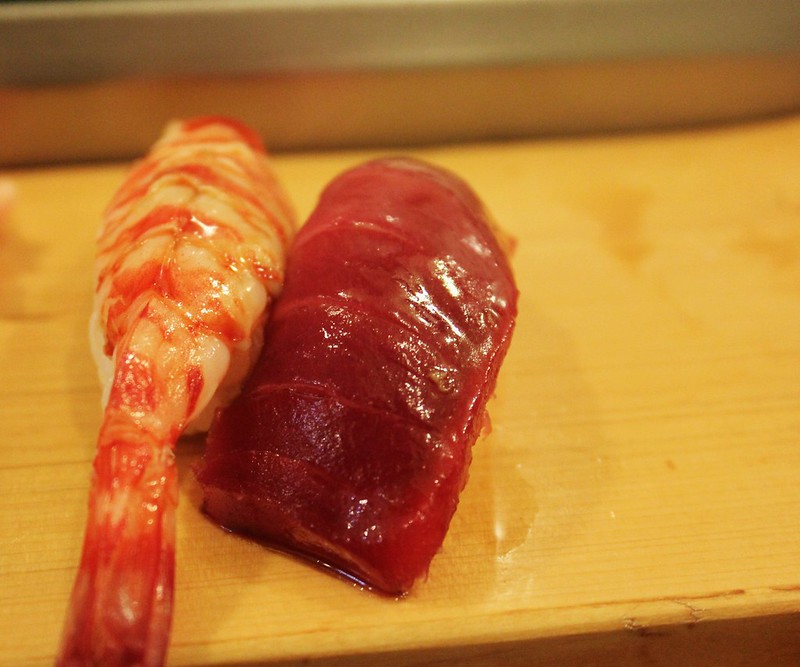
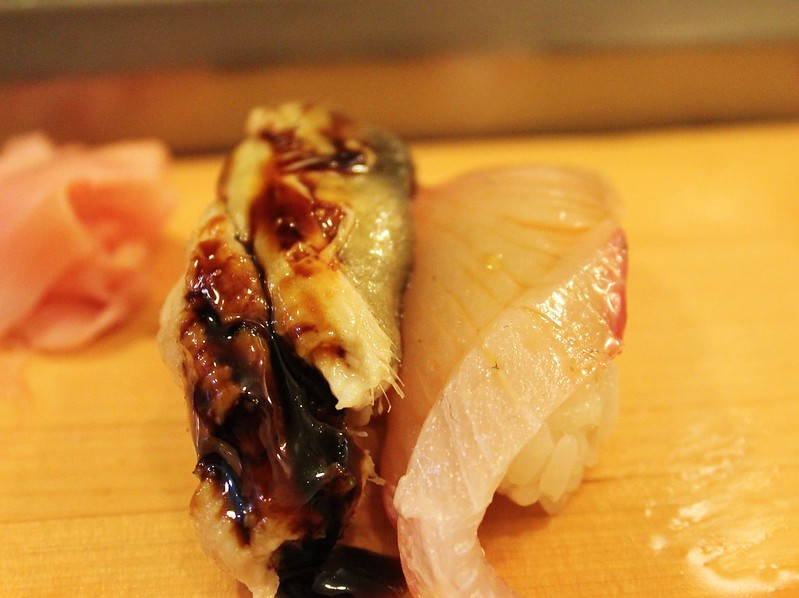
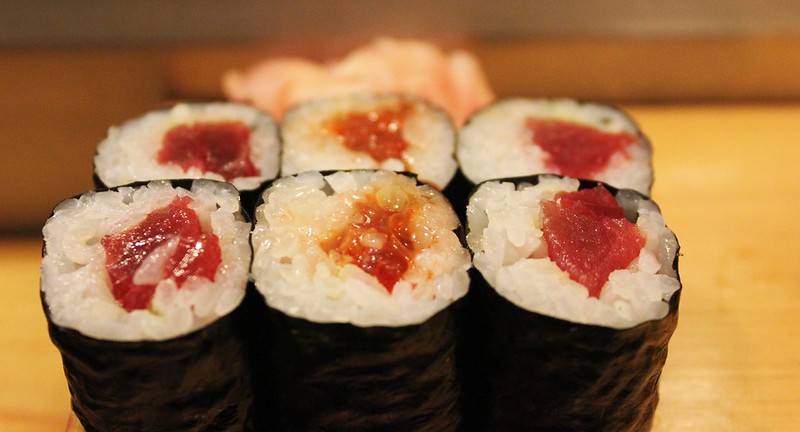
Obviously, there's plenty of fish to be found at Tsukiji, some more exotic than others. But there's also some terrific produce. I really wanted to be able to make it to the melon auction (yes, the melon auction), but simply did not want to wait around the market for hours and never made it back. While I'll talk more about Japan's melons in a later post, suffice to say that there are melons/pumpkins that sell for hundreds of dollars here. I was lucky to be visiting during the heart of matsutake season and apparently, the season has been very strong and the prices very low (though still quite expensive).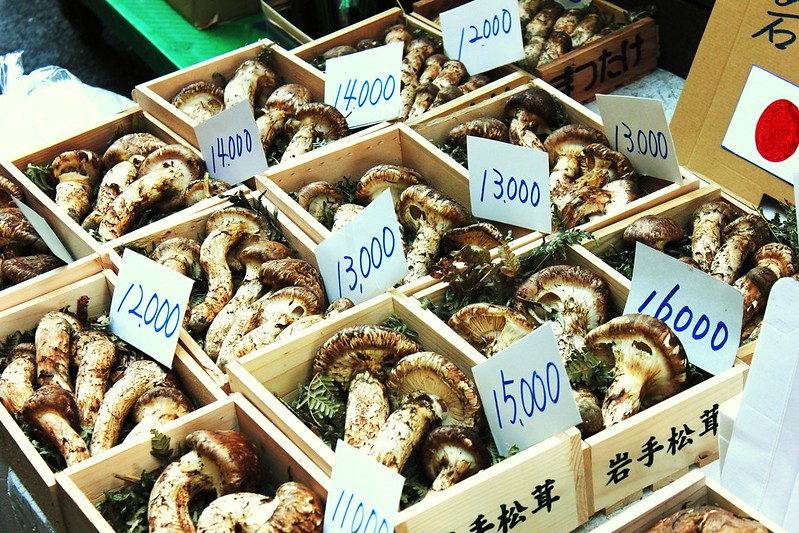
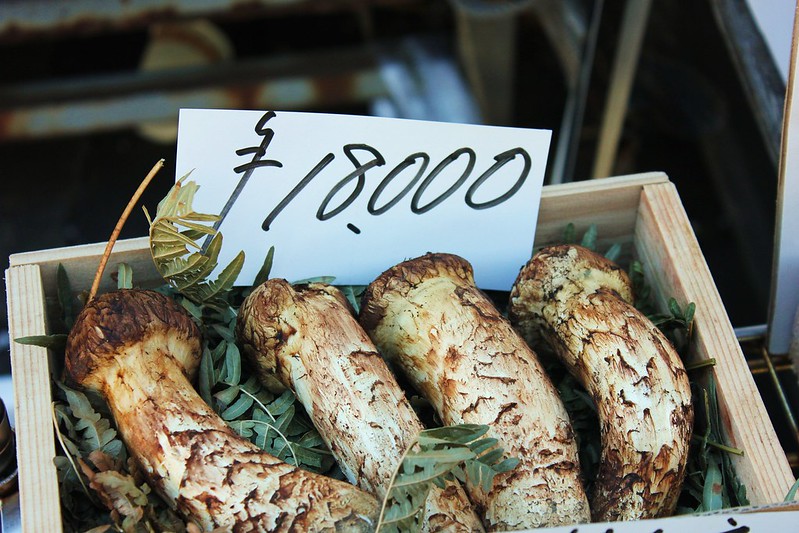
Matsutakes - the ones below were selling for 18,000 Yen per kilogram, which is close to $90/pound.
And of course, plenty of fresh wasabi: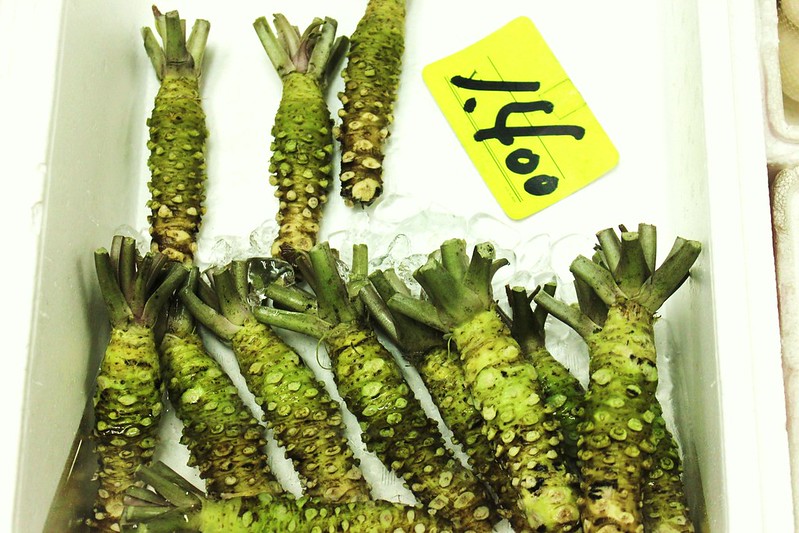
I'll have a lot more on my trip in other posts - ramen, tempura, kaiseki, izakayas, tonkatsu, teppanyaki, more sushi, takoyaki, sweets . . . in eleven days, we ate extraordinarily well and saw so many fantastic sights, and yet it seems like we hardly touched the surface of Japanese food. I look forward to sharing more.
-
-
Post #19 - October 13th, 2013, 8:23 amReally enjoyed your post and photos, BR, and am looking forward to more."Your swimming suit matches your eyes, you hold your nose before diving, loving you has made me bananas!"
-
-
Post #20 - October 13th, 2013, 9:56 amThanks Katie - happy to hear you enjoyed.
Adventures in Ramen eating in Tokyo
There is no shortage of great ramen in Tokyo, but in the past if you wanted to seek out the very best, you needed the names of the shops, locations, and even that didn't necessarily help you in this gigantic city where addresses (and even Google Maps) do not necessarily lead you to the right location. Add in the difficulties of estimating where you think you might be during a particular day of sightseeing, and trying to find a convenient ramen shop and the task is even trickier (well, unless your sole mission is eating and you're willing to hunt down food all day).
But Tokyo has taken a lot of the stress associated with being an American (non-Japanese speaking/reading) tourist out of the ramen-hunting adventure. In 2009, four of the most famous ramen shops in Tokyo were invited to open up in Tokyo Station, a large subway and rail station with a vast shopping and eating area (more like a Water Tower Place and 900 North Michigan combined than a train station). In 2011, four more were invited to join. This area of Tokyo Station is now known as Ramen Street. Now don't let me suggest that all that you need to do is make it to Tokyo Station. Once there, expect to walk up to at least one information or ticket booth to at least get started in the right direction. Tokyo Station is a marathon of walking in the making if you allow it to be. But at least when you see the sign pointing you in the right direction, you should be okay.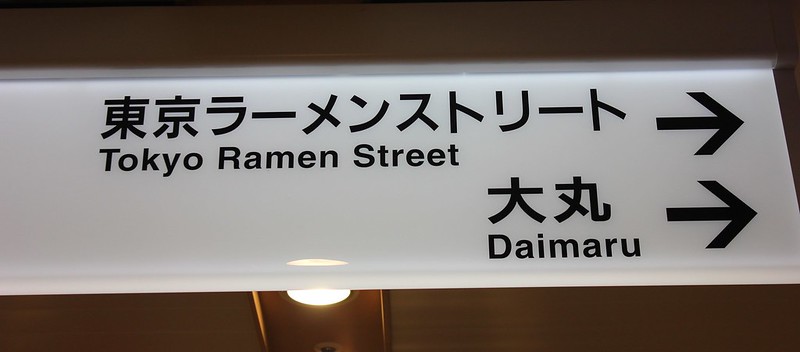
During five days in Tokyo, we found ourselves in Tokyo Station and hungry two times. Even better, we were there well after normal lunch time so we were not met with the hour-plus lines I have read about. The tougher choice was deciding which two of eight ramen shops to visit. On our first visit, I was in the mood for shoyu ramen and so we visited the highly acclaimed Shichisai, which is apparently known for its shoyu ramen.
Of course, merely knowing I wanted to visit Shichisai was not enough. I also needed to figure out which one of the eight ramen shops was Shichisai. Luckily, you'll find a map once you arrive at Ramen Street.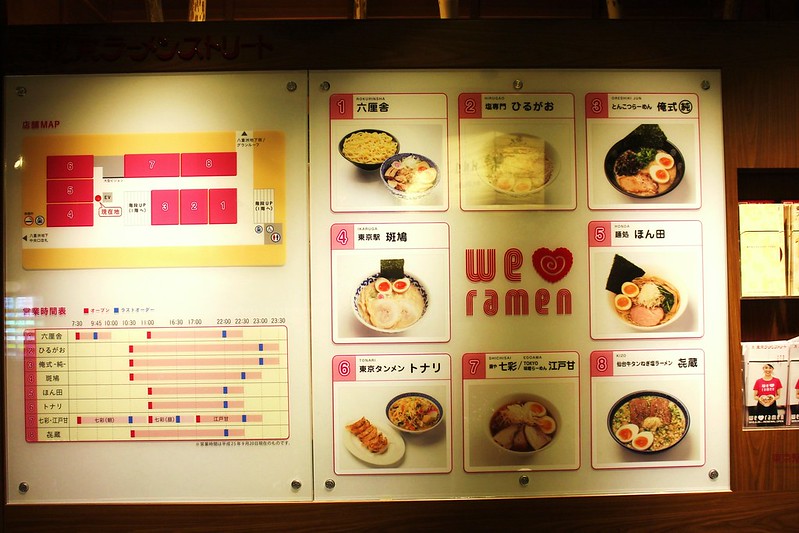
Ramen Street map
Luckily, Shichisai also had its name in English.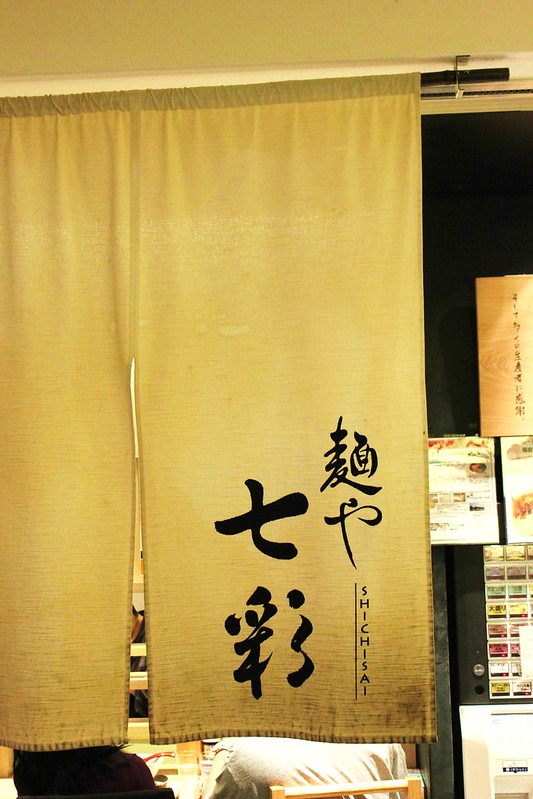
But even once we made it to Shichisai, we were not home free. There was the damn ticket machine. While many ramen ticket machines in Tokyo (including Tokyo Ramen Street) have pictures, the one at Shichisai only listed words.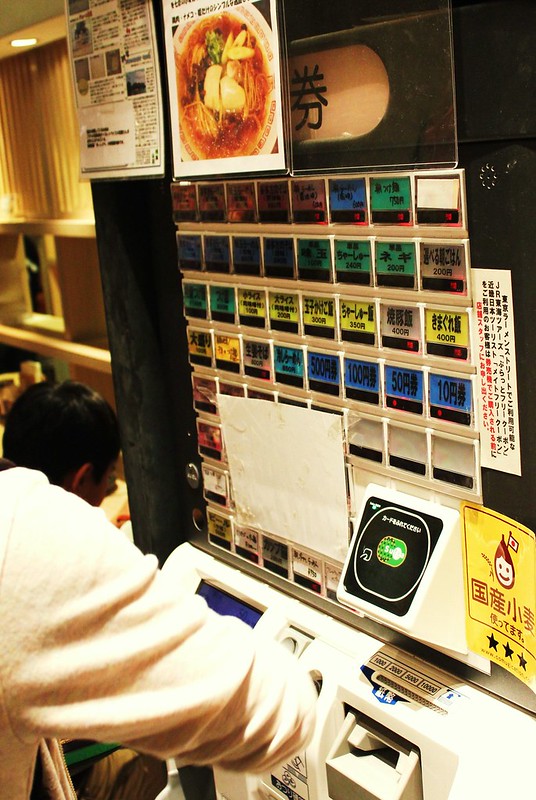
Ticket machine to order ramen at Shichisai
Luckily, one of the employees spoke just enough English to get me the ramen I desired. I wish my pictures of this ramen matched the quality of this bowl of ramen, but it was really terrific. While the broth was delicious and rich, it was the chashu pork and the noodles that really elevated this bowl. The pork was tender, nicely fatty and incredibly flavorful (and plenty of it). And the noodles were the best ramen noodles I have yet encountered. Thicker than ones I typically encounter here, a little curly, and nicely chewy. While waiting in the short line, I observed bowls being delivered in the restaurant and noticed most people quickly (and loudly) slurping the noodles upon delivery of the ramen, which I assumed was the right way to ensure that each noodle was eaten at its textural peak.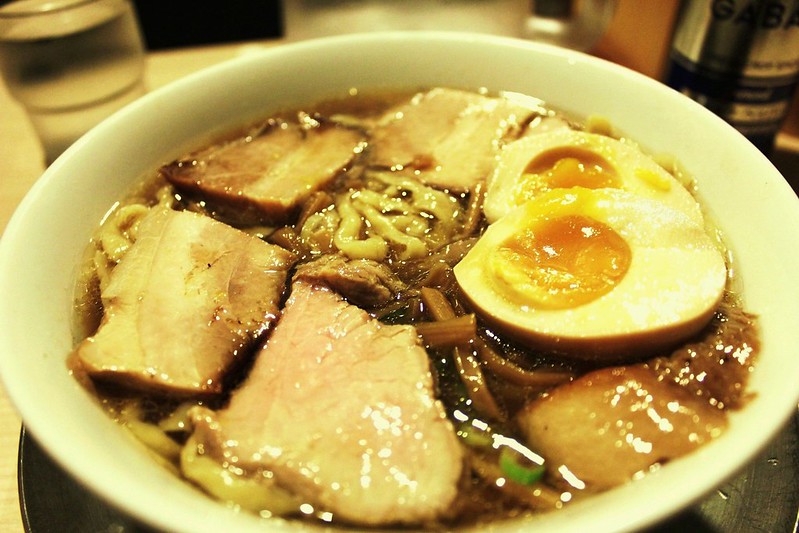
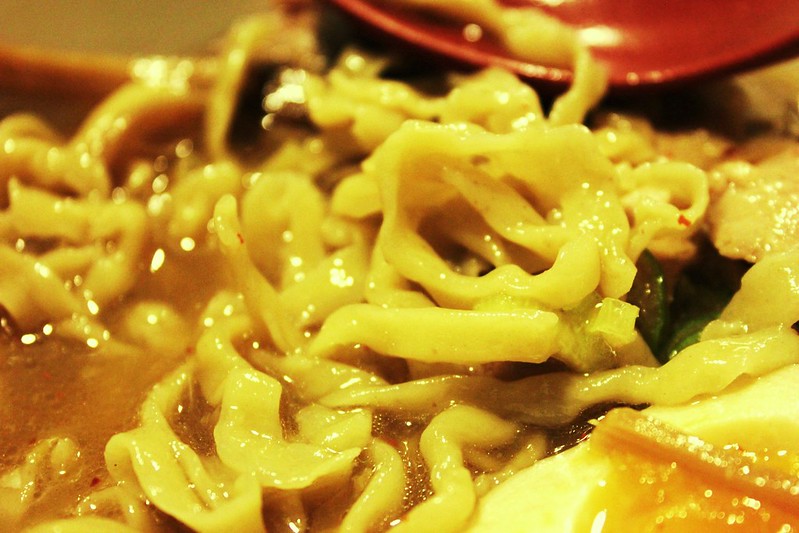
Shoyu ramen at Shichisai, bottom picture highlighting the thickness of the noodles
On our second visit to Ramen Street, we decided to give Rokurinsha a try for its tsukemen, i.e., dipping ramen. Despite arriving at about 3:30pm, we were still met by a decent line (which wraps around the corner).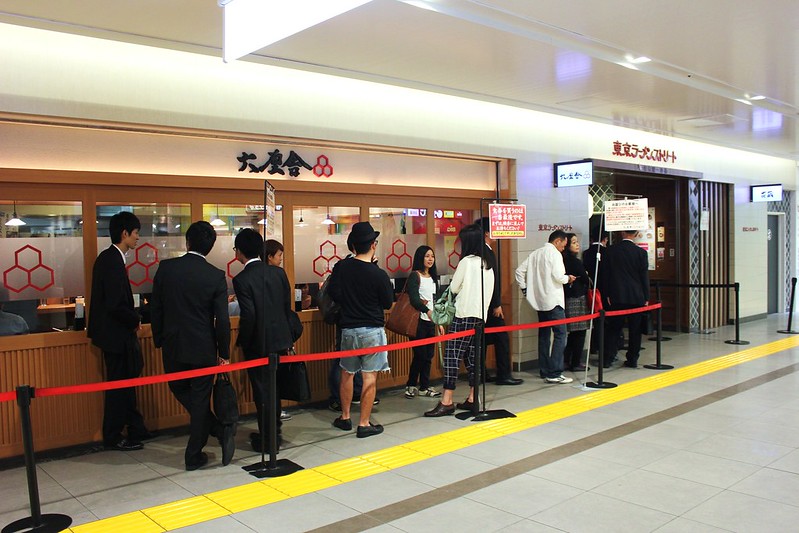
Line at Rokurinsha
We were pleased that the machine at Rokurinsha had pictures, which made it a little easier to order my bowl, which included additions of shredded pork and egg. Before I go into more details, check out the two parts to the tsukemen, the broth (or sauce as the case may be) and the noodles: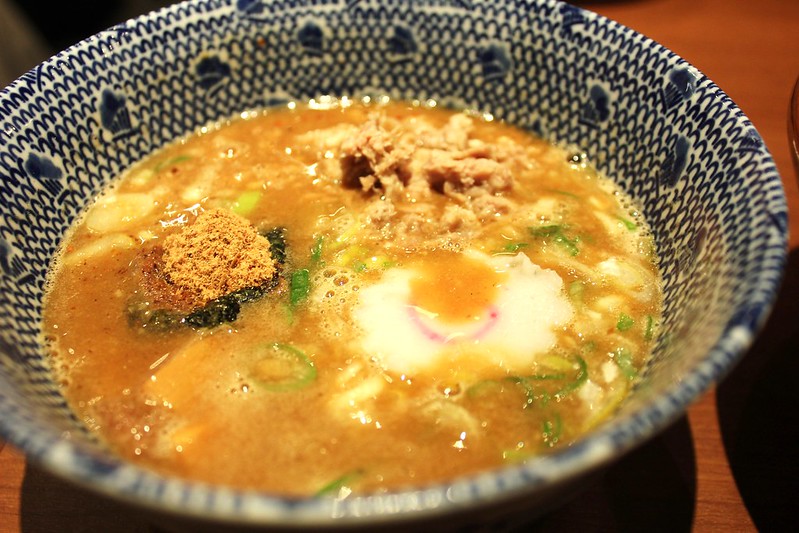
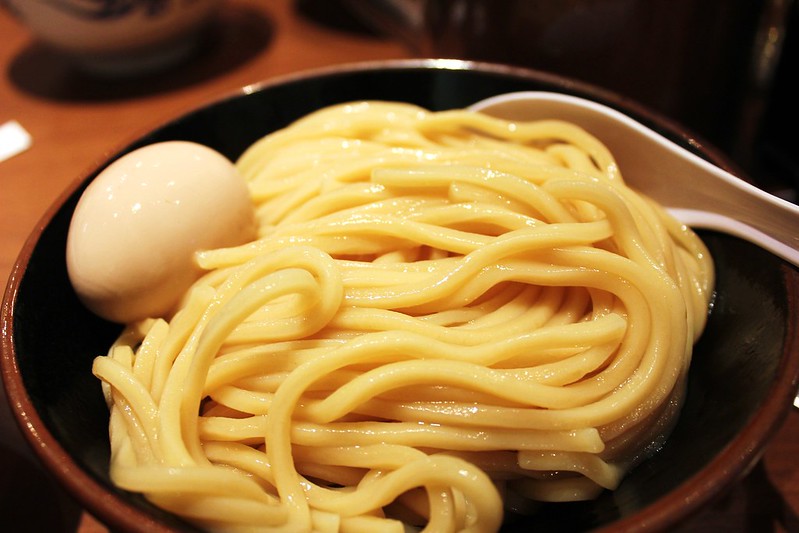
Tsukemen ramen, soup and noodles, at Rokurinsha
The noodles were really thick, like a thick spaghetti, and thicker than the ones at Shichisai. I suppose this is probably necessary with tsukemen ramen. They're also served cool, perhaps slightly cooler than room temperature. You dip (carefully) the noodles into the broth and slurp. The broth itself was very thick and far richer and delivered more intense flavors than at Shichisai - very porky and fishy all at the same time, and intense bursts of both. The visible ground fish powder topping added to the intense flavors.
When you're done with your bowl of noodles, the staff comes by and offers you more broth which moderately lessens the richness and intensity of the soup, but makes it easier to go down. Ultimately, a terrific bowl of ramen but I slightly preferred the bowl at Shichisai because of the outstanding pork and noodles. While the broth at Rokurinsha was incredibly thick and rich, it might have been a bit overload for my personal tastes. Great at first, perhaps artery clogging a little later on. But don't get me wrong, it was excellent.
Of course, if you're a bigger fan of ramen than I am, you'll be happy to hear that there are six other highly regarded ramen shops within feet of these two shops, offering many different ramen variations, in terms of broth, noodles, pork and more. But if you ended up at both Shichisai and Rokurinsha, you'd be just fine.
-
-
Post #21 - October 13th, 2013, 8:26 pmLes Créations de Narisawa - I ate fugu (pufferfish) and I lived to tell about it
Narisawa is just 5 spots behind Alinea on S.Pellegrino and Acqua Panna's World's 50 Best Restaurants list so I was anxious to see how the two restaurants compared. What I found were many delicious and exquisite ingredients, often beautifully presented, and a truly outstanding meal, though not one that would measure up to Alinea in my opinion.
The menu itself may not have been very helpful, though I'll try to walk you through it with some pictures (not so ideal given the lighting) and descriptions (hopefully better than the pictures). I should also note that Narisawa offers just the tasting menu.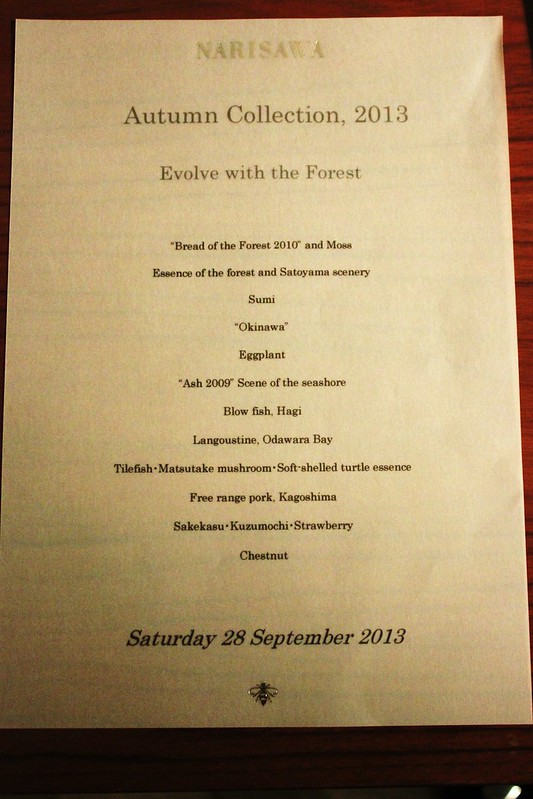
The evening begins with some very traditional Japanese touches - a warm, moist towel and chopsticks.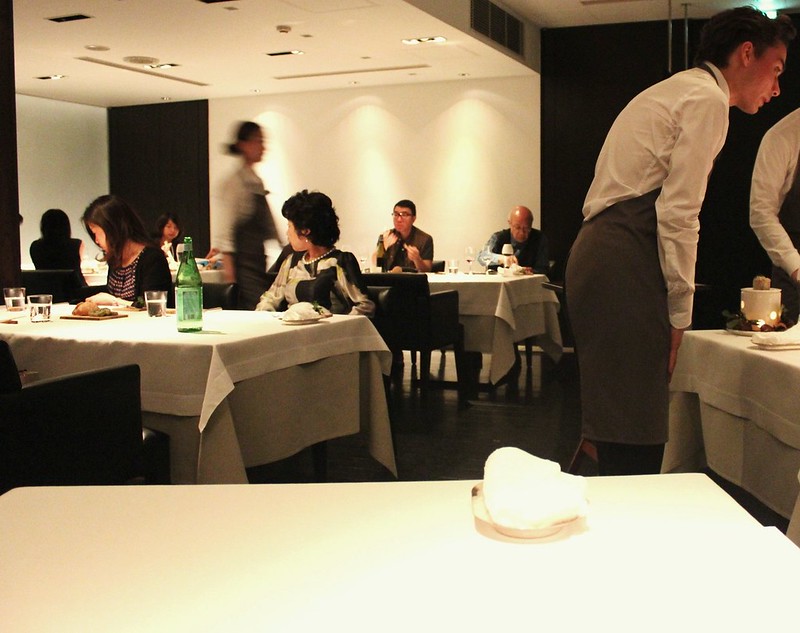
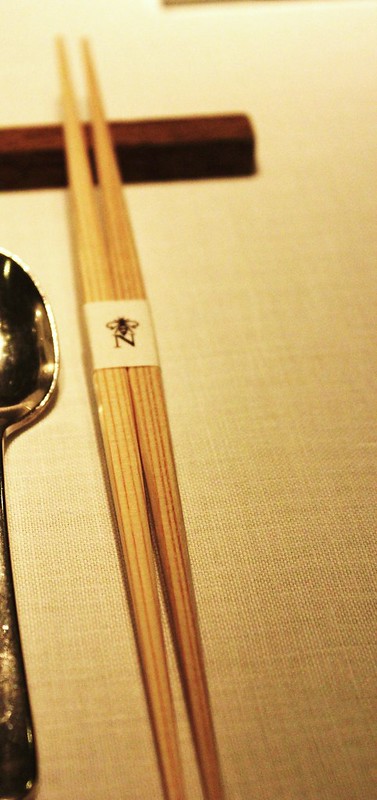
The meal begins with "Bread of the Forest 2010" and Moss:
What the above picture reveals is a test tube of sorts holding a bread dough, with the bread to be prepared tableside. I'm not sure what the reference to 2010 is, perhaps when the dish was conceived or when the starter was begun. One of our servers would return to the table to prepare the bread. He scooped it into what must have been a very hot baking dish (we were warned not to touch), and was then baked for maybe 30 minutes on the table.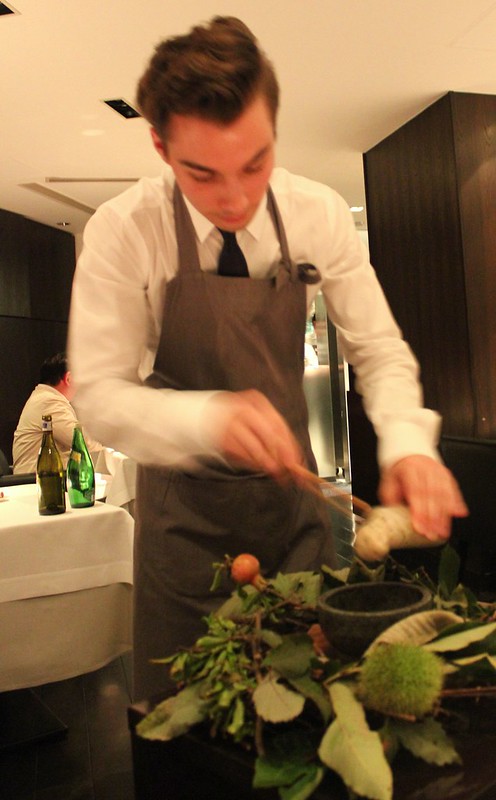
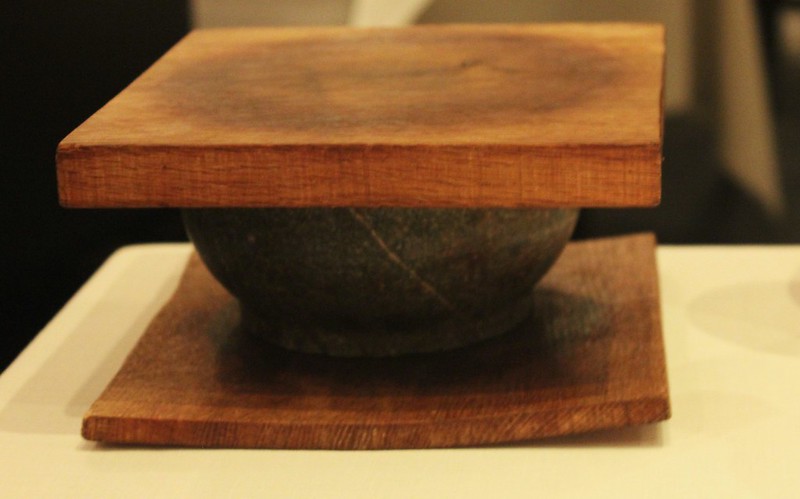
Bread of the Forest baking
The first course we ate was Essence of the forest and Satoyama scenery, meant to showcase the forest and the nearby agricultural landscape. There was crispy burdock, green tea, soy, fresh spring water served in the piece of wood, herbs, tempura of sorts. Perhaps more of a palate awakener than anything else, but the flavor combination was unique and enjoyable.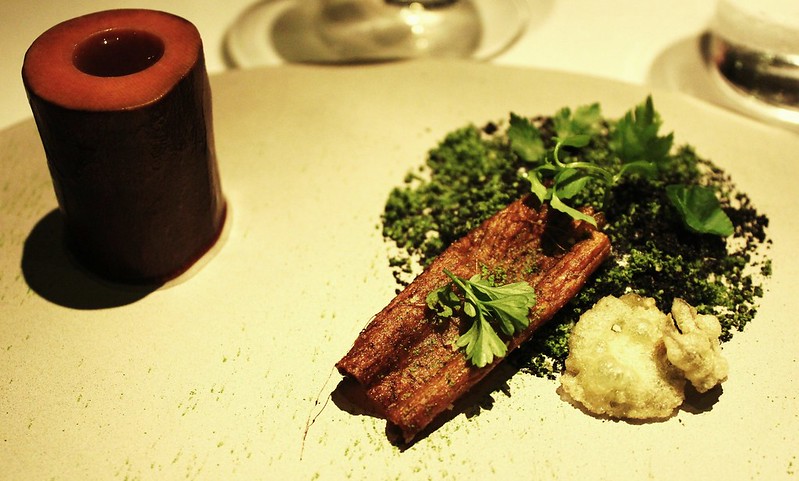
Essence of the forest and Satoyama scenery
The second course, Sumi, was a mere couple of bites, but one of my favorite courses of the evening. It's worth checking this dish out before you know more about it.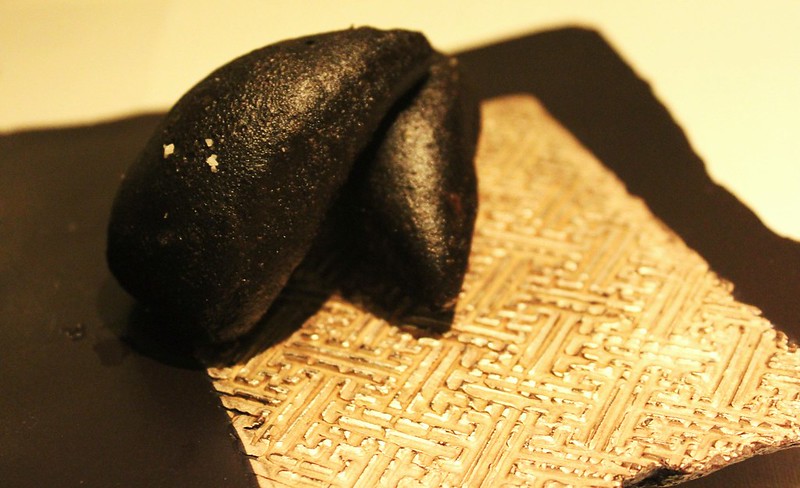
What you're looking at is leek that has been charred to make a vegetable ash of sorts, and the charred leak surrounds a single piece of onion. Biting into the soft, earthy exterior led to a soft, sweet piece of onion and a remarkably delicious combination. I'm really curious about the charring technique because it really offered a unique and delicious flavor.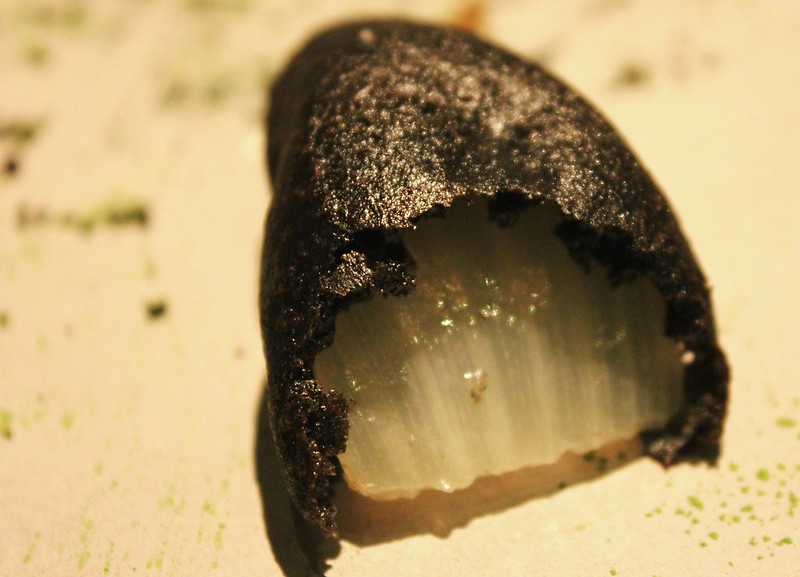
Sumi
Our next course, Okinawa, was a sea snake soup with crisp pork and a fritter. While I cannot recall what was inside the fritter, I recall amazement that it retained some of its crispness and didn't fall apart inside the rich broth. The pork lent an additional richness to the flavorful broth.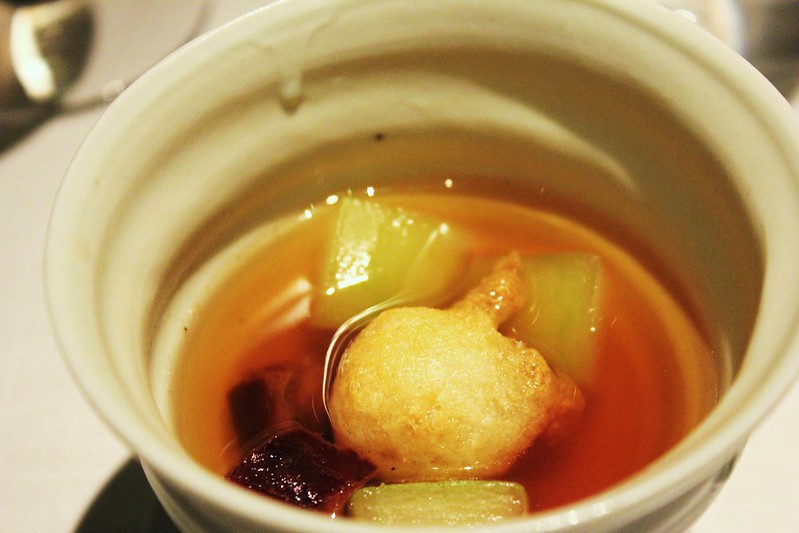
Okinawa
Perhaps the most beautiful and complex course of the night was ironically referred to simply as eggplant. Obviously, there was a lot more going on - edible flowers, a clear sheet of tomato jelly, herbs and mushrooms. Though the beauty surpassed the flavor, it was nonetheless delicious.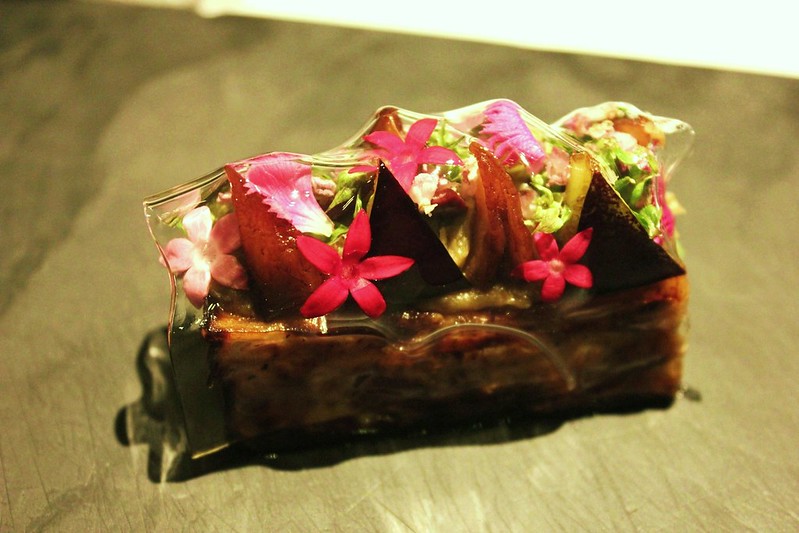
Eggplant
Another one of my favorite courses of the evening followed. "Ash 2009" Scene of the seashore was intended to evoke thoughts of freshly caught and grilled squid. What appeared on the plate to be a lone piece of squid atop a dab of smoked paprika sauce was then finished with liquid nitrogen and vegetable ash for a stunning presentation. More importantly, the squid was tender, delicious and the flavors truly heightened by the accompaniments.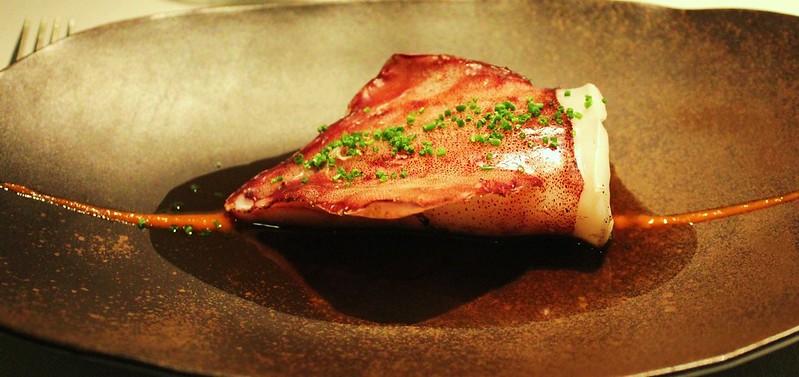
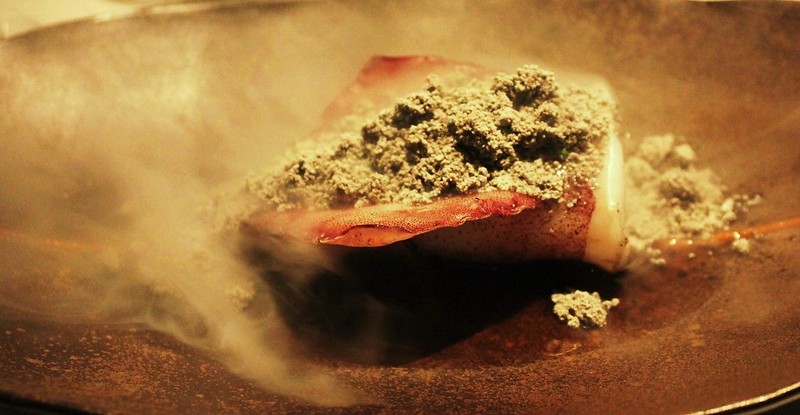
"Ash 2009" Scene of the seashore
We had been wondering for the last course or two why the bread supposedly cooking on our table had not been served to us yet. We recalled our server saying that it would bake for 20-25 minutes and we were sure that time had passed. We also noticed that the bread had been served at other tables almost two courses earlier. But before we could say a word, the bread was served. To me, it turned out to be more form over substance (though my dining companion really enjoyed it). I was disappointed that there was no crust to speak of and the interior was more chewy than doughy. It was served with a butter meant to look like a moss-covered rock, and the butter was really terrific. But I still wonder whether they erred with the bread service. We were also served a crusty and delicious loaf of sourdough bread and some green tea bread, which served as better vehicles for the butter.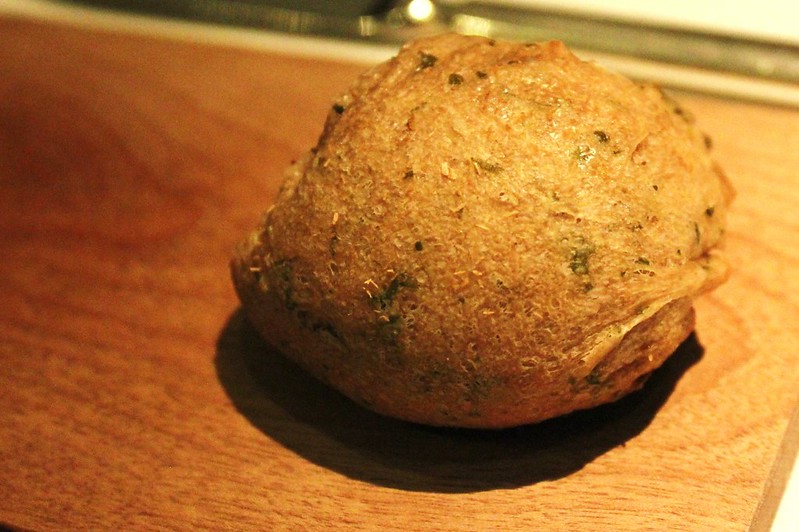
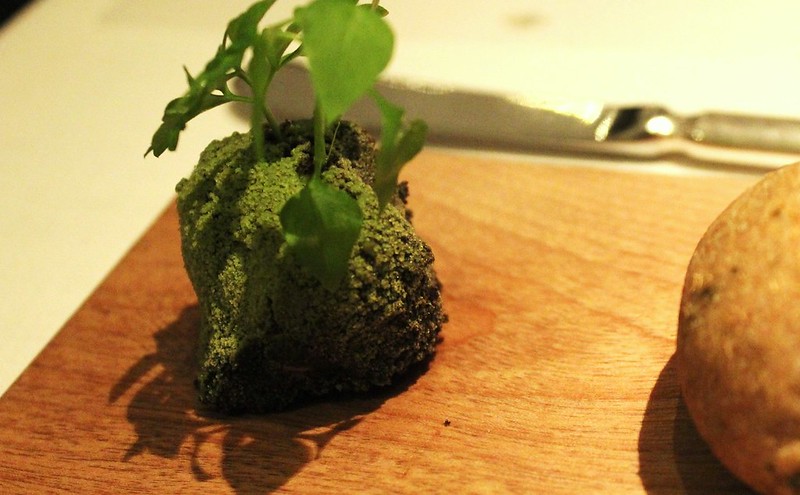
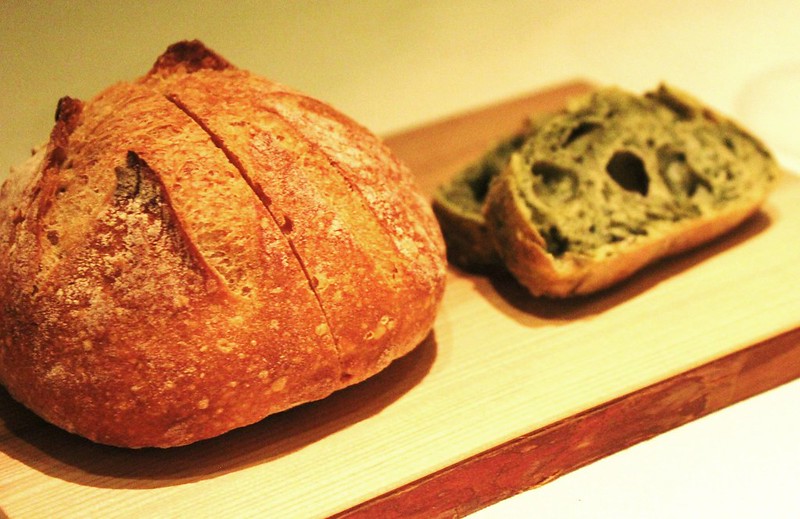
Top to bottom, tableside prepared bread, butter, sourdough and green tea breads
I was very confident that I would not be eating fugu, the potentially deadly pufferfish, on this trip. But plans changed when I was served fugu at Narisawa. I didn't have any concerns really - I was satisfied that this restaurant has achieved too much to risk everything by killing some dumb Chicagoan. The fugu was beautifully fried to a light crispness, in paper meant to reflect how casual fried foods are often served in Japan we were told, seasoned with salt and pepper and a small wedge of sudachi, a Japanese citrus. We squeezed the sudachi over the fish, then picked up the paper wrapper to eat the fish. The fugu itself was quite meaty and reminded me of swordfish. Best of all, I'm still alive to write about it.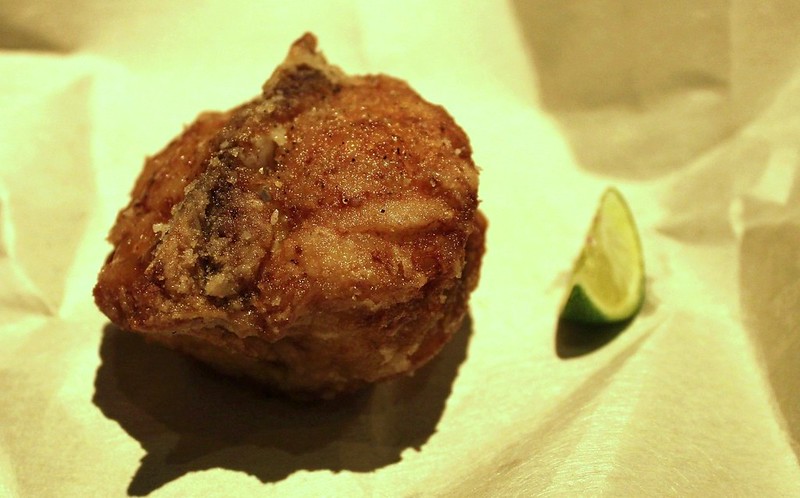
Blow fish, Hagi
The fugu was followed by a magnificent, perfectly cooked langoustine.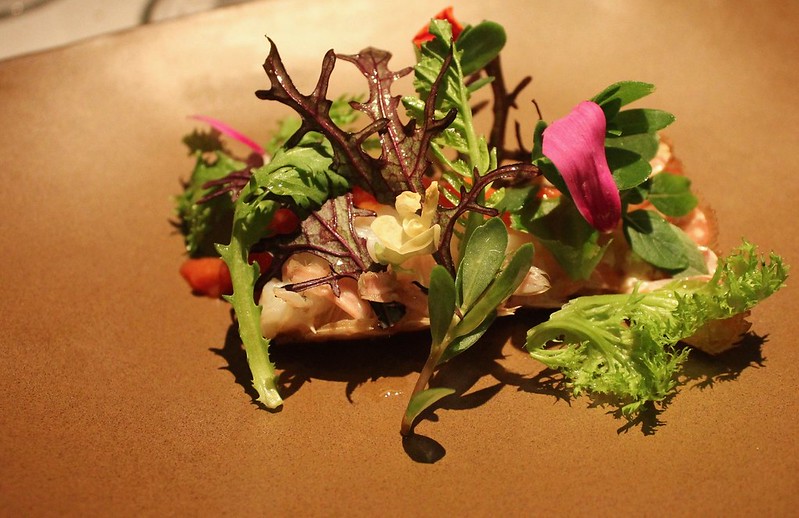
Langoustine, Odawara Bay
A bag was then cut open on my plate, revealing a dashi broth with softshell turtle essence, tilefish and sliced matsutakes. I really enjoyed the flavors here, although the tilefish might have been lost and I found the dish to be texturally one note. But the high quality broth and fragrant matsutakes are really what needed to be admired.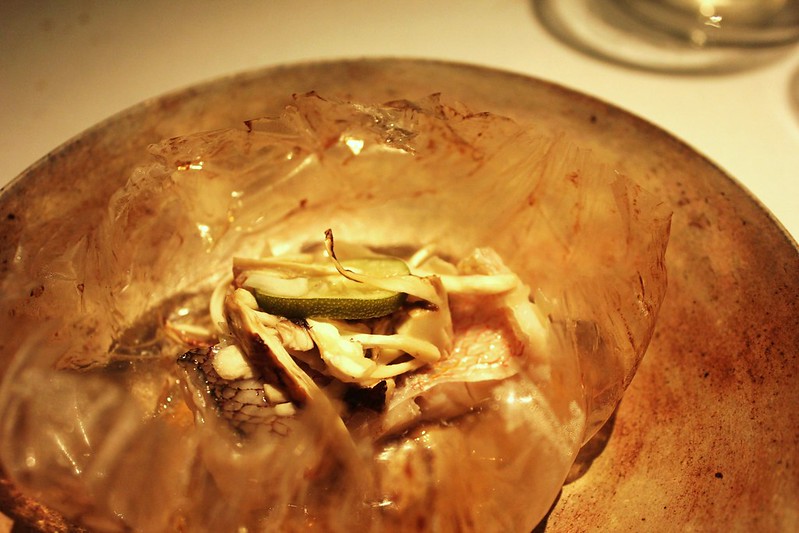
Tilefish, Matsutake mushrooms, Soft-shelled turtle essence
At the beginning of the evening, we were told that we could choose between beef or pork for our "meat" course. We both chose pork. Kagoshima is known for its Kurobuta pork, and this pork dish was sensational, and easily the best pork I've ever tasted. It was incredibly rich and you can obviously notice the marbling.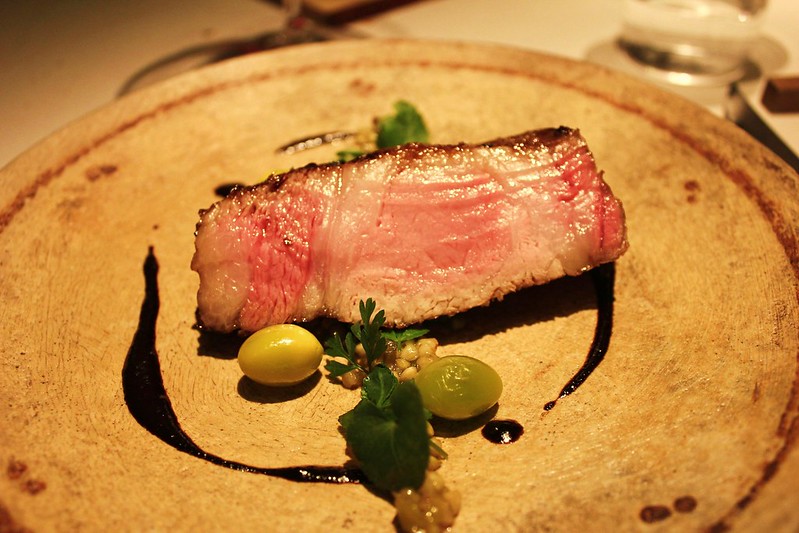
Free range pork, Kagoshima
We then moved on to dessert. The first dessert was more of a palate cleanser, and an outstanding one at that. There was a strawberry sorbet, sakekasu (think yogurt, this is what is left over following sake production) and kuzumochi, which were small cubes of mochi made with kuzu, Japanese arrowroot, which I learned about (and used) when making a tomato-olive oil sorbet for last year's LTH picnic.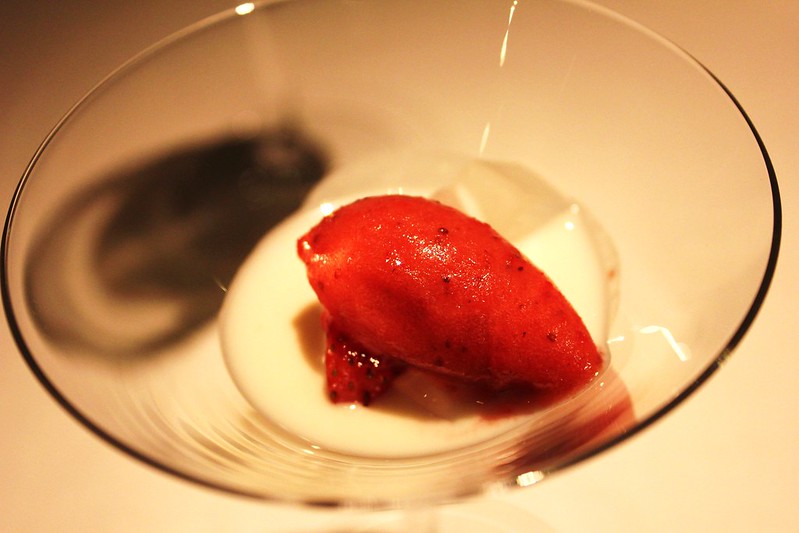
Sakekasu, Kuzumochi, Strawberry
I suppose the main dessert was what followed, and it was simply called Chestnut. With fall approaching in Japan, we noticed chestnuts being offered everywhere, in many forms, and usually with lines of people. This dessert certainly served as a reminder of fall's approach.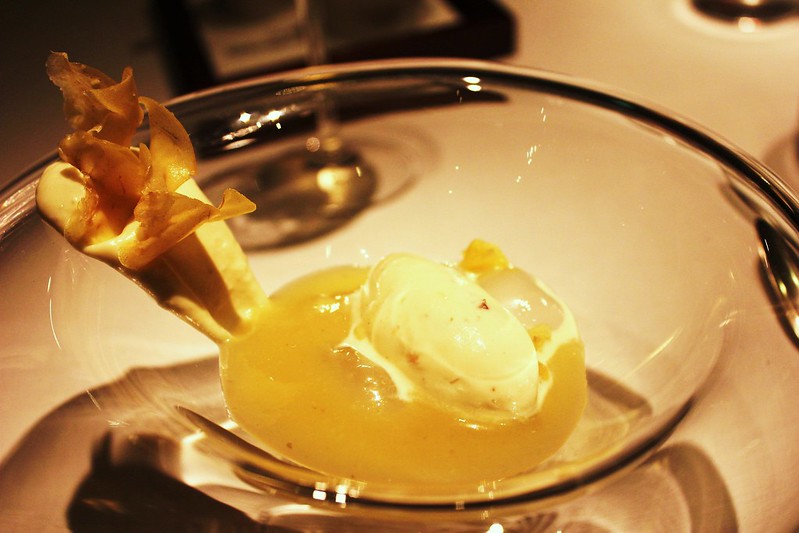
Chestnut
When I said that the chestnut dessert was supposedly the main dessert, I said that based upon the table of mignardise that was rolled out to us at the very end of the meal. I wish my picture had been better, but oh well, you get the idea.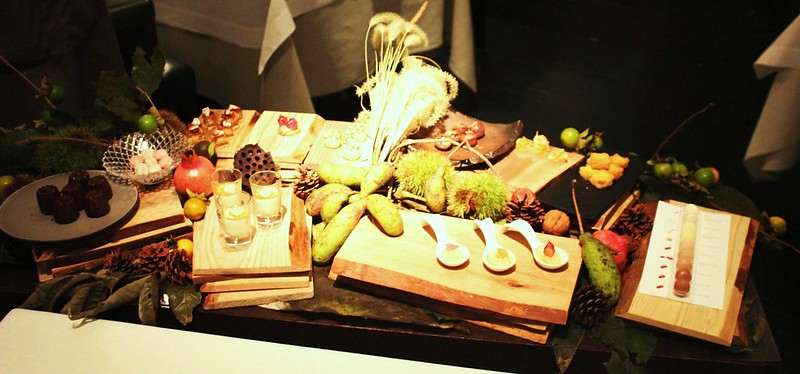
There was this amazing array of miniature macarons: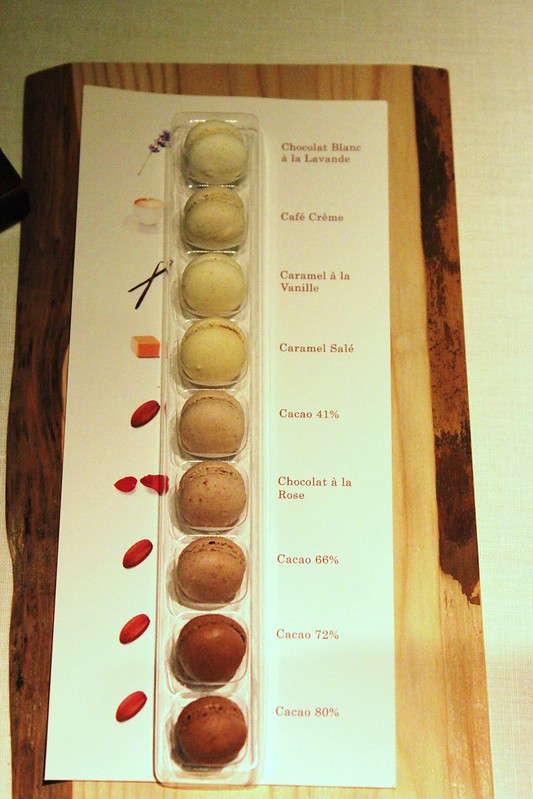
When it came time to select from the table of mignardise, I suppose I could have engaged in a careful consideration. But I did not. I politely asked if I could have one of each, and there you had it. I can't recall every item, but there was an amazing chocolate canele, a pate a choux pastry with walnuts, a maple custard, and obviously quite a bit more. This was a stunning finish to a great meal.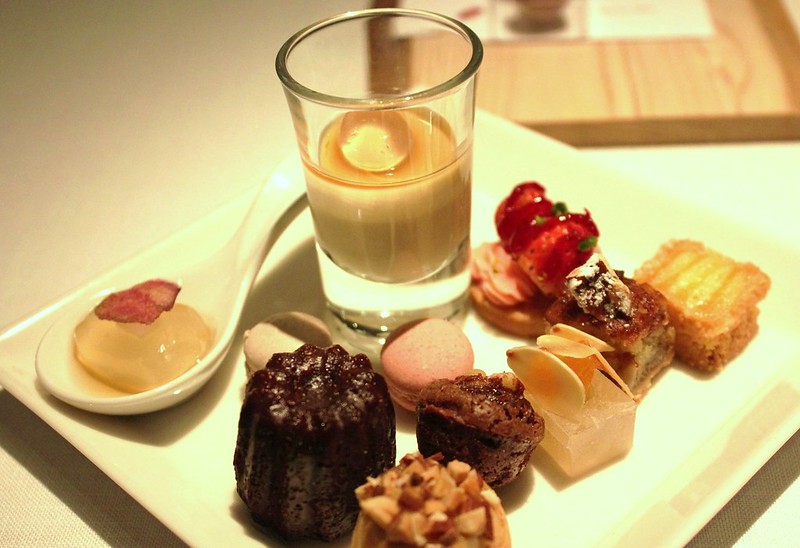
Overall, it was an outstanding meal. I suppose the only disappointment of the evening was the tableside bread. My three favorites were probably the pork, the squid and the Sumi. We also appreciated the staff's ability to speak English. Interestingly, our main server was from France, and teaches English during the day. I was surprised to learn that while he enjoys food, he has no interest in cooking (and yet finds himself at Narisawa).
-
-
Post #22 - October 14th, 2013, 8:04 amHoly cow, BR, that looks amazing. Thanks for your posts of your Japanese eating adventures.-Mary
-
-
Post #23 - October 14th, 2013, 12:24 pmBeautiful stuff, BR!
What's the procedure now for getting into the tuna auction? I've been to Tsukiji a number of times, but I've never done the auction. I'm going to be back there in a couple of weeks, and I'm thinking it might be a good idea to get in there before the move.
Yeah, I'm not surprised about the wait at Dai. When I was there last year, I arrived at 4:45 (15 minutes prior to opening - we stay a short walk away so I didn't need to wait for the subway to open), and I missed the first turn by maybe six or seven people, so it was about an hour wait. I think the best plan is just to be there at 4:30, wait a half hour, and be in on the first seating. That said, I'm thinking about doing Daiwa on this pass.
-
-
Post #24 - October 14th, 2013, 4:12 pmDmnkly wrote:What's the procedure now for getting into the tuna auction?
Bottom of this page has the details - http://www.shijou.metro.tokyo.jp/englis ... ukiji.htmlNever order barbecue in a place that also serves quiche - Lewis Grizzard
-
-
Post #25 - October 14th, 2013, 6:39 pmThanks for the compliments guys.
Dom, I'd first recommend that you don't go on a Saturday. I was led to believe that if you're not there by 4am on a Saturday, your chances of getting in are minimal. And note that Tsukiji is usually closed on Sundays. Don't forget to consider the melon auction though - I think that would be very interesting too. I believe not only melons are auctioned - squash, pumpkins, apples, cherries, grapes, etc.
To give you an idea of what I'm talking about, here's a musk melon (very similar to a cantaloupe) in a department store selling for 15,750 Yen, a little more than $160. And I know from reading that there are melons that sell for considerably higher prices.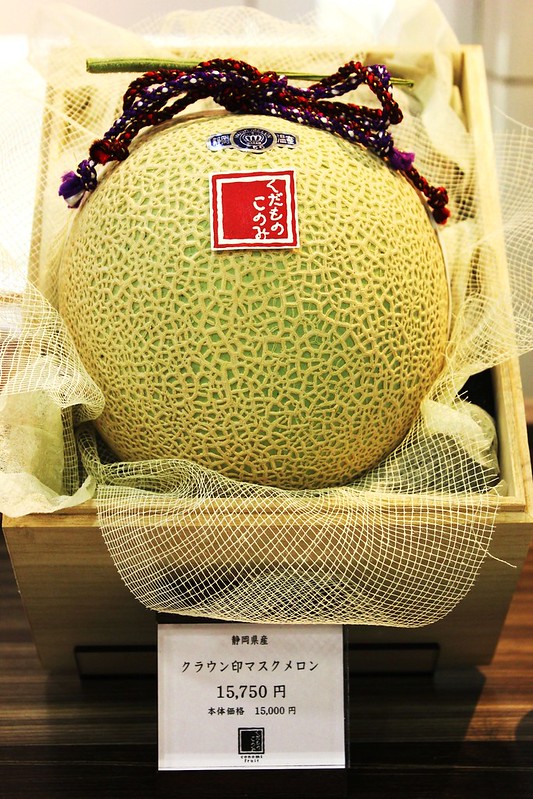
I haven't studied the history of Japanese agriculture to understand this level of devotion, but I find it fascinating. My understanding is that it is not just about the perfect appearance, but that the flavor is superior and that the melons are juicier. That being said, this gaijin wasn't about to spend $100+ on a melon. I understand that they're simply considered luxuries that are usually purchased as symbolic gifts, much like we might purchase a bottle of Dom Perignon as a congratulatory gift. But don't get me wrong - this level of perfection, this ever-present sense of dedication to ones craft, be it cooking or growing, was constantly smacking me in the face in Japan, and making me yearn for this level of dedication in the US, be it at farmers' markets or restaurants. I wonder whether we in the US are more willing to settle for acceptability and not as willing to push harder to attain perfection, or even excellence. But I digress.
These melons were so precious that they were behind glass in a department store:
Even in what seemed to be a very pedestrian grocery store, melons were selling for nearly $30.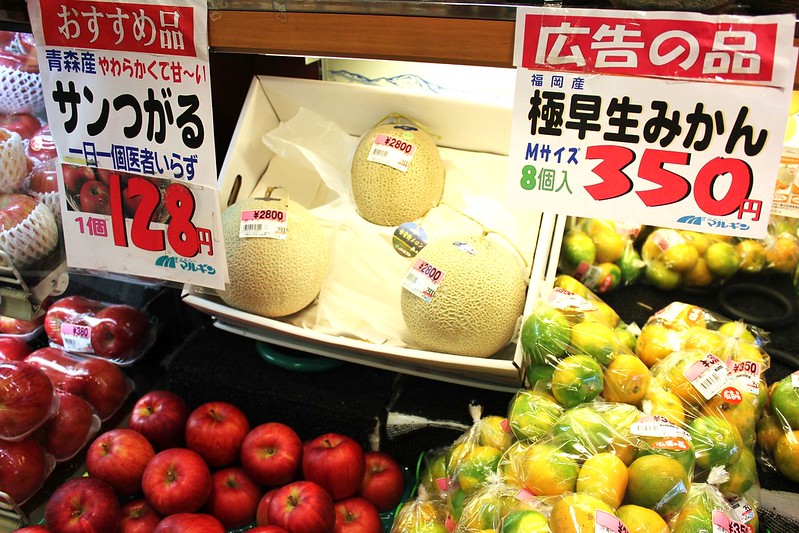
And how about a small box of purple and green grapes . . . for $60: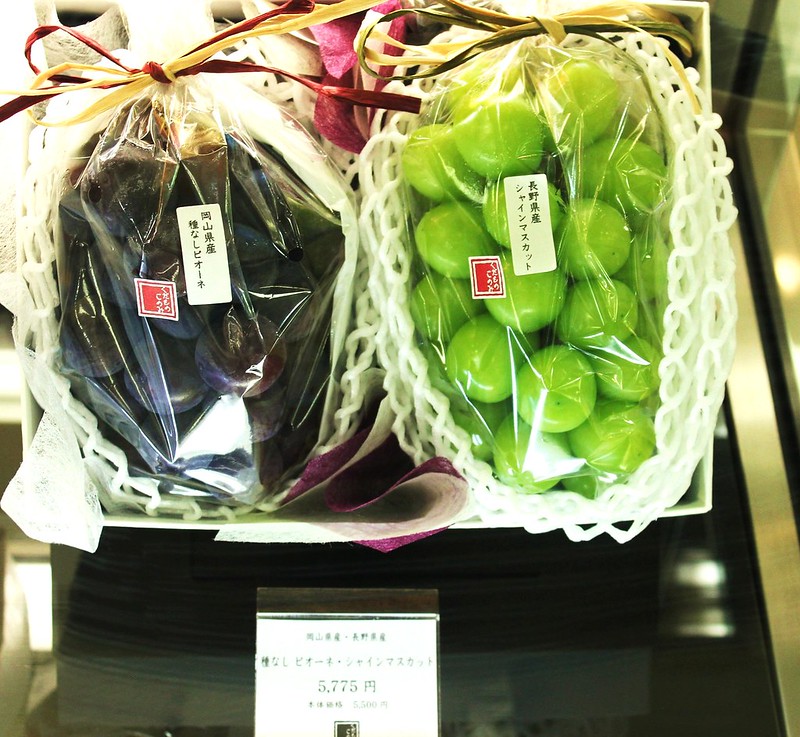
So if you share my curiosity, you might consider visiting the melon auction at Tsukiji market. At this time of year, you might just find some spectacular squash and pumpkins. Though I didn't see any, I understand that they sell pumpkins that are even perfectly square.
-
-
Post #26 - October 14th, 2013, 6:56 pmThe Japanese premium fruit is absurd... both absurdly expensive and absurdly good. I've not partaken of the melons, though I've seen them up to about $300-400. Once, however, we accidentally ordered $40 peaches in a restaurant. And it's in the running for the best $40 I've ever spent. I cannot describe to you the perfection that this peach was. It was like they crammed the flavor of ten peaches into one perfectly unblemished peach-sized package. Completely otherworldly. I once had some of the premium strawberries as well, the most perfect texture and flavor and the size of your fist.
I've also had a few pieces of premium fruit that disappointed in terms of price performance, but man, when it's on, it's completely indescribable. Whatever you're imagining isn't even close.
-
-
Post #27 - October 14th, 2013, 8:30 pmPub food - Izakayas
Based upon my experiences at places like Raku in Las Vegas, and Sumi Robata Bar here in Chicago, I knew I would love the food that I expected to find at izakayas. But while Raku and Sumi Robata Bar offer food typically seen at izakayas in Japan, the atmospheres could not be any more different than the typical izakaya in Tokyo. Moreover, those places are far more expensive than what I experienced in Japan, even Tokyo. We visited a few izakayas during our trip, but unfortunately I only brought my camera once and only took a few pictures. But the food was absolutely outstanding and quite inexpensive. And though the atmospheres could not be any more casual, walk into the right joint and you'll notice predominately Japanese men who have gathered post-work, in their white shirts and black suits, to throw down a pitcher or several and enjoy some great food.
We didn't know which izakayas to visit - we hadn't mapped out this part of our itinerary. Instead, we walked around neighborhoods where we found ourselves in the evening (though be careful, many stop cooking at 10pm), we looked in many izakayas (tip - spot the red lanterns outside the establishments indicating that they are inexpensive dining spots) and when we saw a combination of large crowds of locals enjoying themselves and a robata grill, we entered. There are countless izakayas so this does require some patience and effort. Sometimes these izakayas are located basement level, requiring you to go down the stairs and walk in to see if there's a crowd . . . don't be shy. The best one we found required just that type of effort: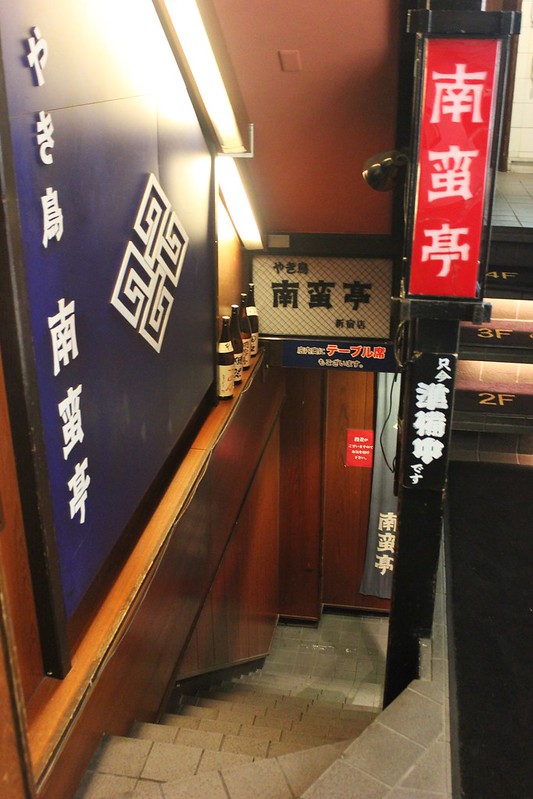
And this is one example of what you might find in terms of grills: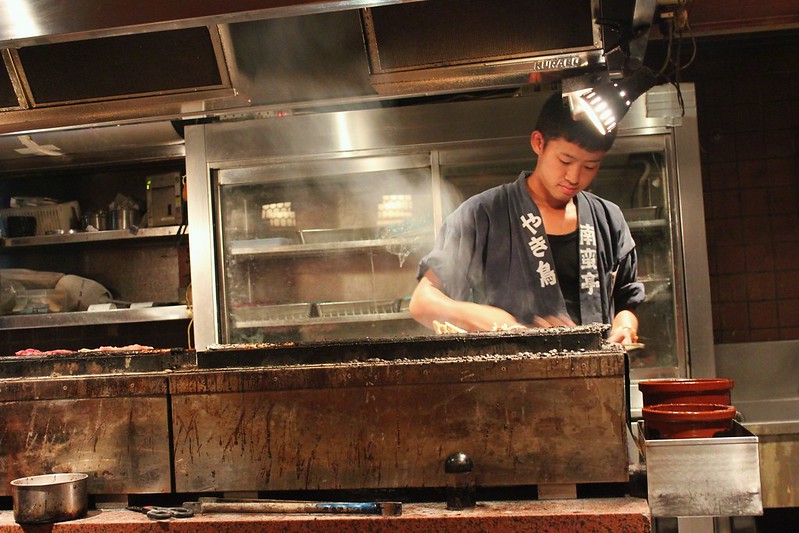
We enjoyed a number of outstanding items at the various izakayas - from the robata grill: shishito peppers, pork heart, beef, salmon, tsukune (chicken meatball) . . . to name some I can recall. We also enjoyed a few orders of chicken karaage (Japanese version of fried chicken), which I just love, chicken donburi (chicken & rice), rice and matsutakes that cooked in stone kettle of sorts in front of us, and of course tsukemono, Japanese pickles.
The beef dish pictured just below was terrific, not only because of the very flavorful and perfectly cooked beef, but also the fantastic accompanying wasabi sauce, really a Japanese chimichurri if you will, but so much better. I absolutely need to try to duplicate this effort.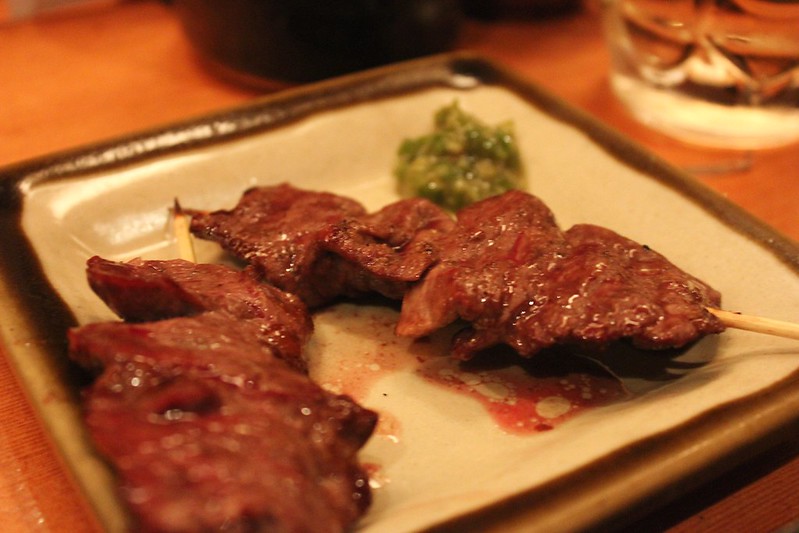
I can't recall if this was the chicken skin or thighs from the picture, but I remember loving everything from this particular izakaya, though the chicken skin might have been the best version I've ever tasted.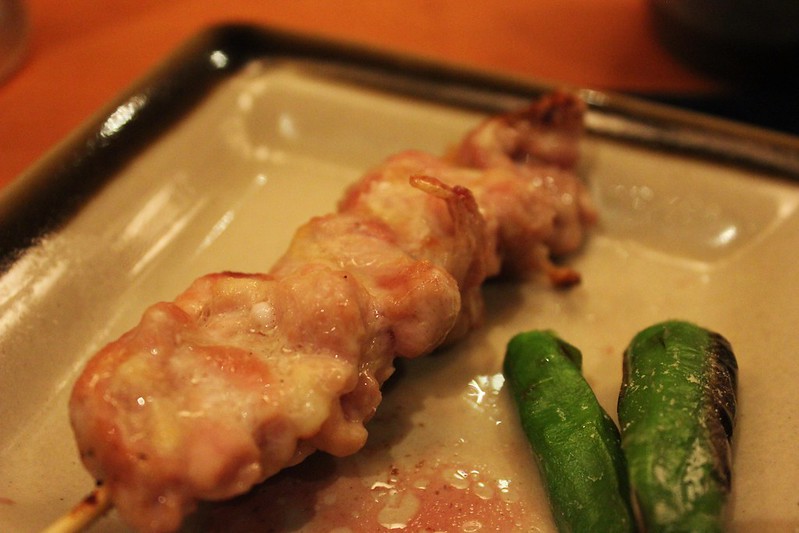
When we ordered the following chicken dish (the shishitos were separate), we were told it was served rare. I'm sure they realize Westerners only order their chicken cooked through and simply wanted to warn us. Well, when in Rome, or Tokyo as the case may be . . . Actually, I felt more comfortable than that eating the rare chicken in Tokyo, far away from the factory farms that have caused us to forget what real chicken tastes like. In any event, rare or not, it was great.
And of course, chicken karaage. The following picture wasn't the best version I tried on this trip, but all three versions we tried were excellent. Honestly, the very best version I've ever tried is at Raku in Vegas. But for those here in Chicago, Sumi makes a great version too.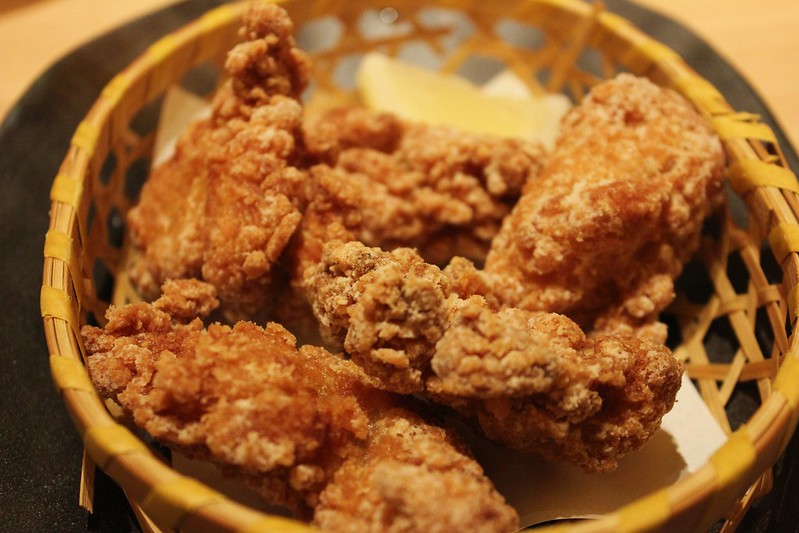
Chicken karaage is typically boneless chicken, marinated in garlic, ginger, sake and soy, then coated with potato starch (though corn starch and flour are also often incorporated). The result is typically an incredibly crispy bird. What I love about Raku's version is how they separate the skin from the meat, the result being a thinner, more brittle crust, and yet a remarkably moist and flavorful bird.
As for drinks, the cocktails of choice were typically pitchers of beer, and that's what we did. Nothing fancy at the spots we found, Kirin, Asahi, etc.
I just don't see us having anything of the pub experience that Tokyo has, i.e., an ultra-casual spot to grab a beer and get great food. Toon's has really nice bar food, but not at the level I'm talking about. And while I enjoy a number of items at Three Aces, Owen & Engine, and burgers at Bad Apple, again they just seem to miss the mark, no disrespect intended. What I'm thinking is something almost at Avec level in terms of quality, and places like Avec are few and far between. In any event, when in Japan, do not miss the izakayas.
-
-
Post #28 - October 15th, 2013, 8:51 pmMore sushi - Sushi Kanesaka, Tokyo
We had two sushi meals on our trip, the one at Sushi Daiwa (at Tsukiji Market) mentioned above, and then for dinner at Kanesaka. We wanted one high end sushi meal and debated a number of choices. While our concierge was willing to camp out for us to get a reservation at Sukiyabashi Jiro, I had read almost as many negative reviews as positive. The complaints were not at all about the food, but rather how welcome average westerners who don't speak Japanese are at the restaurant (though westerners are apparently very welcome at the Roppongi branch run by Jiro's son). Some restaurants expressly refuse entry to people who don't speak Japanese or are not accompanied by someone Japanese. So be it - it's not like you can walk into just any restaurant in Chicago without some command of the English language. We then debated between Sushi Saito and Sushi Kanesaka and chose Kanesaka based upon our understanding that the staff might be more welcoming. $300 later, that being for the omakase menu, I would tell you that the quality of the sushi was superb and it was an outstanding meal, but I don't know that I personally would rank it among my best meals in that price range. While you're certainly paying for pristine fish and expert sushi-making, I personally would prefer to spend the $$$ on creativity in cooking. But don't get me wrong, Kanesaka was stellar and certainly the best sushi I have ever enjoyed, in every respect - in terms of the quality of the fish, how the fish was cut to ensure easy eating, temperature, the seasoning of the fish, perfectly cooked rice, etc.
Kanesaka is a cozy place, 14 counter seats total, and 2 sushi chefs: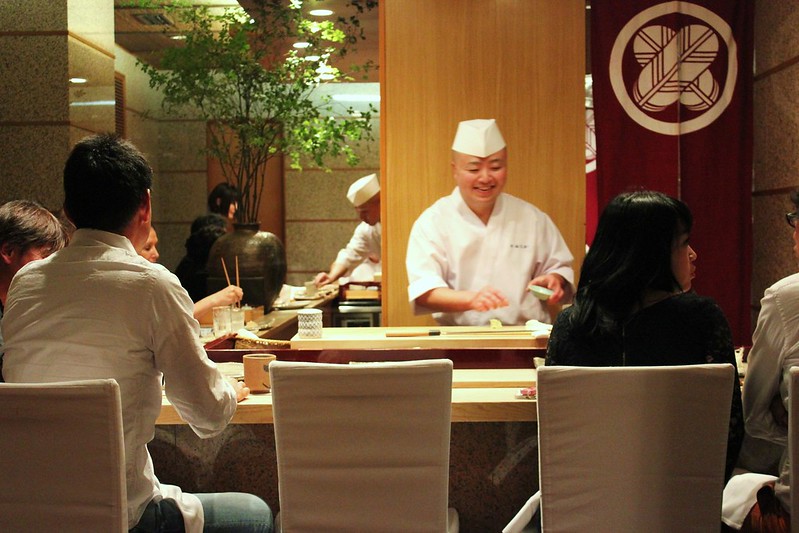
Things got off to a fantastic start with this delicious hairy crab, and a very generous serving at that: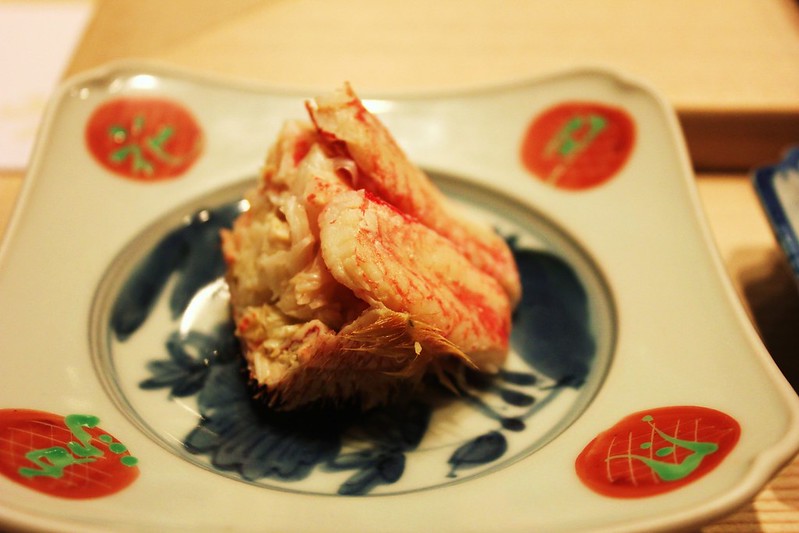
Here's our sushi chef at work: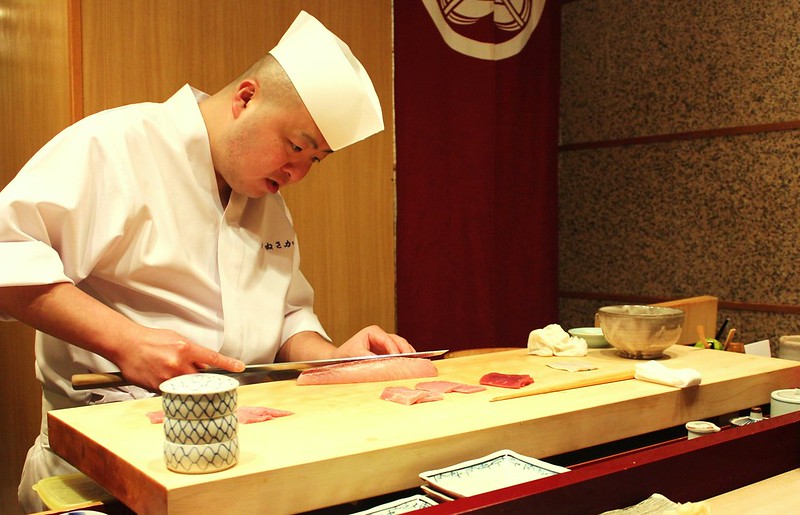
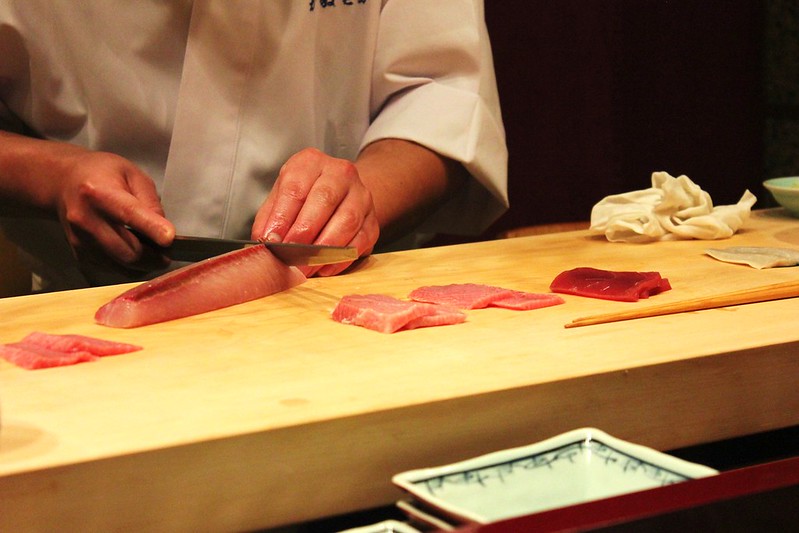
I won't go through every piece we had (though I'll cover most of them), but there were both raw and cooked items, and a couple of rolls. Furthermore, only a couple of items required dipping and they were served with sauces. Otherwise, the chef applied soy and wasabi or other condiments as he deemed appropriate. I wish this was the standard everywhere. We were given a very small amount of soy and told that it shouldn't be necessary. I would equate this with salt on tables at restaurants - try the food first before applying any additional seasoning. So why is it that we give sushi chefs a pass in Chicago when they don't properly season the fish, and instead give you a lump of crappy wasabi and soy sauce? In my opinion, a little serving dish of soy is appropriate but otherwise the chef should properly season the fish.
As for the fish: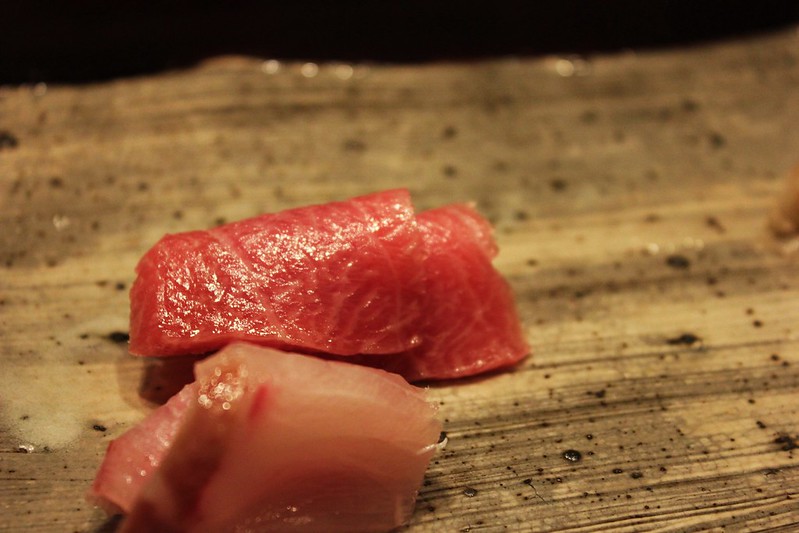
Some lovely, fatty tuna in the background, and two pieces at that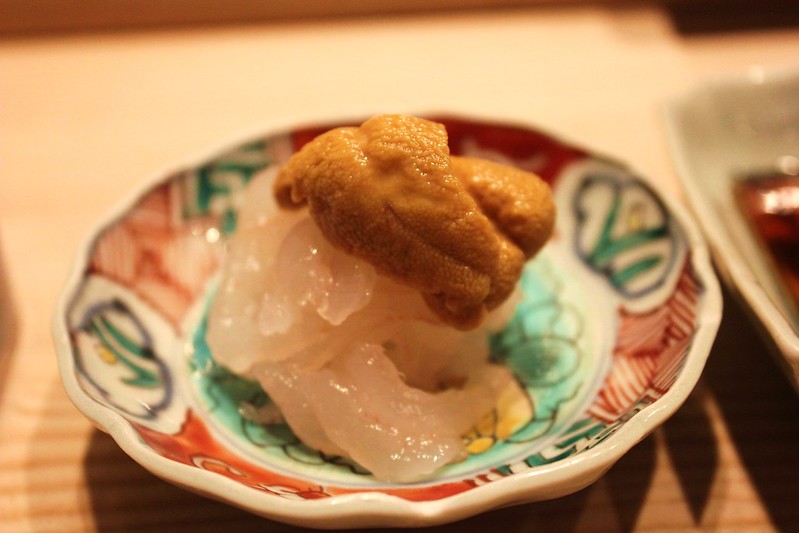
Uni and sweet shrimp - a perfect combination
Steamed abalone - really remarkable, slightly tender yet chewy, and delicious - something I hadn't tried before
One of the most remarkable bites of the evening was this grilled nodoguro, or Blackthroat seaperch. We were told that they are in season in the fall and prized in Japan for their fat and rich flavor (and apparently very pricey). Well, this fish was stunning, perfectly grilled, buttery rich, slightly sweet, with a little daikon fritter to round it out.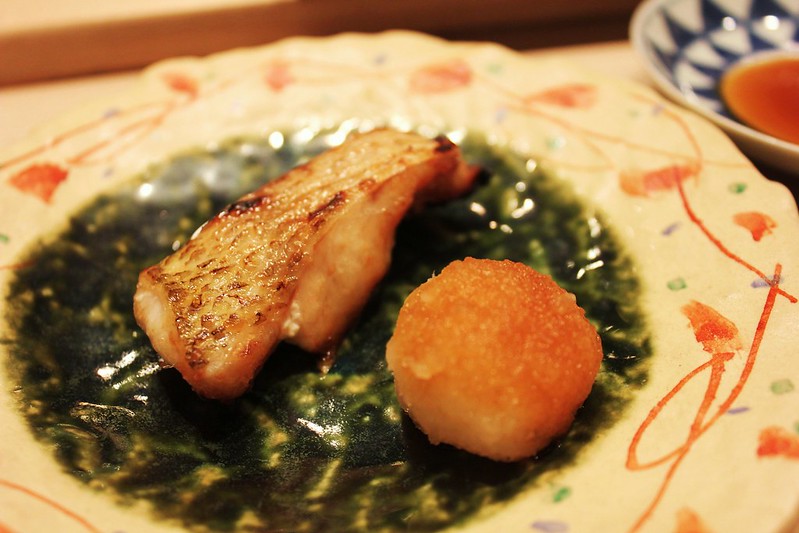
Grilled Nodoguro with daikon fritter
Followed up with more fatty tuna, or should I say even fattier tuna, and really sensational fatty tuna at that, with beautiful marbling:
fatty tuna
And the continuing parade of gems:
Ika - Squid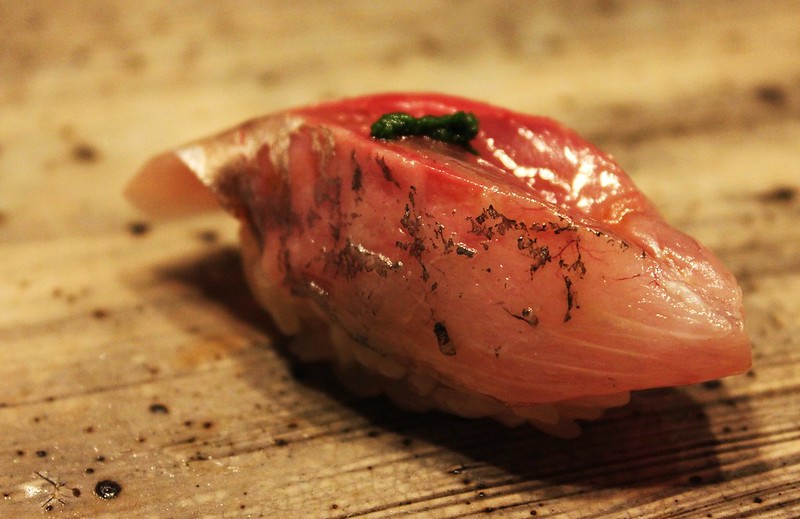
Aji - Horse mackerel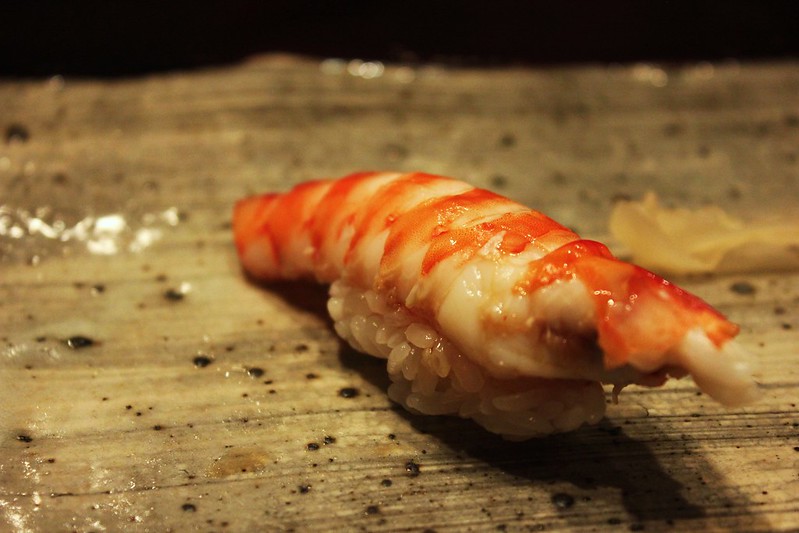
Ebi - Shrimp - what thrilled me here was how the chef maintained the meat and flavors from the head, a rarity.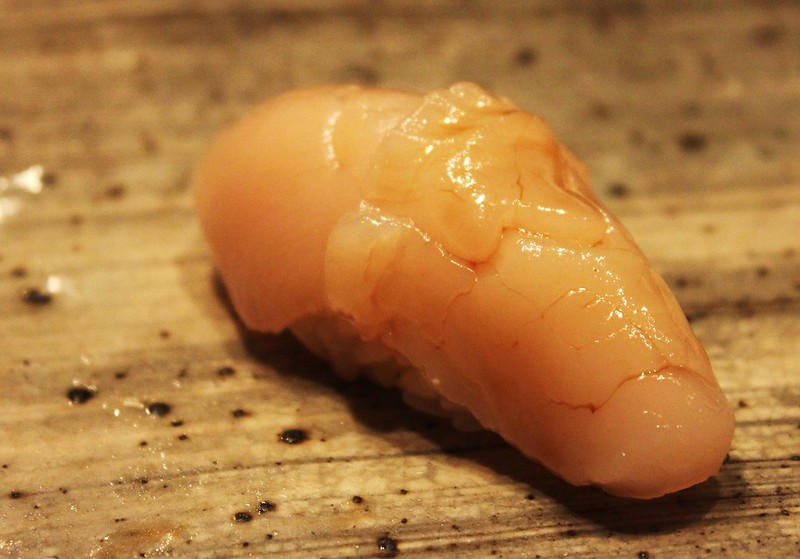
Hotate - Scallop - as perfect a scallop as I have tasted
A palate cleanser???: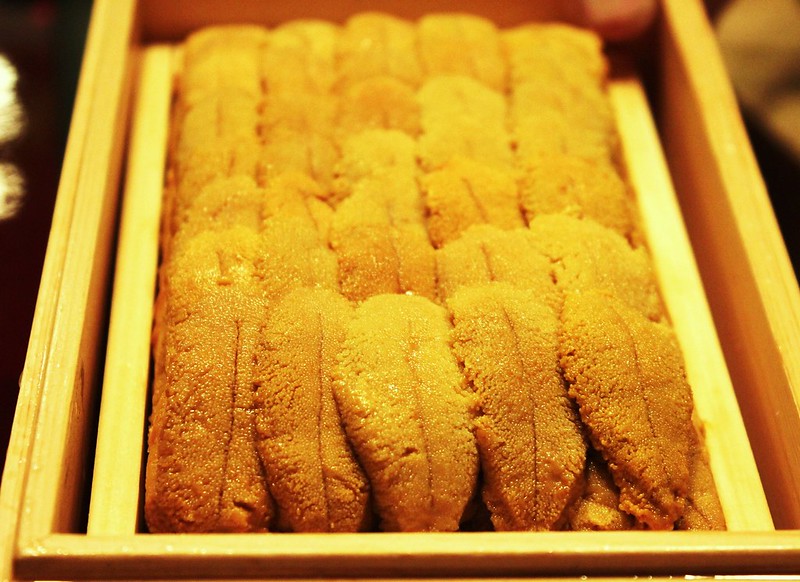
No . . . just a sneak preview. Damn!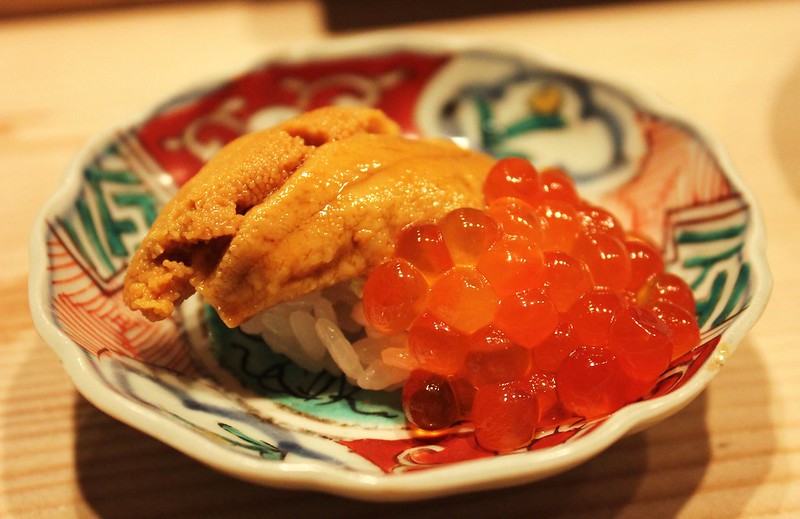
Uni & Ikura - A perfect combination
Though frankly the couple times I had the ikura in Japan I would say it's no better than what I have enjoyed here, not that there's anything wrong with that.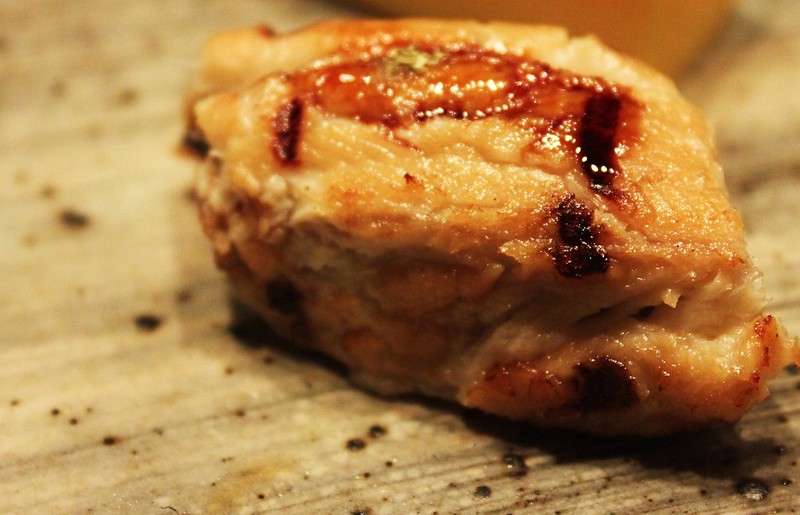
Anago
And tamago that Jiro would be proud of - no air bubbles to speak of, and a very subtle sweet flavor.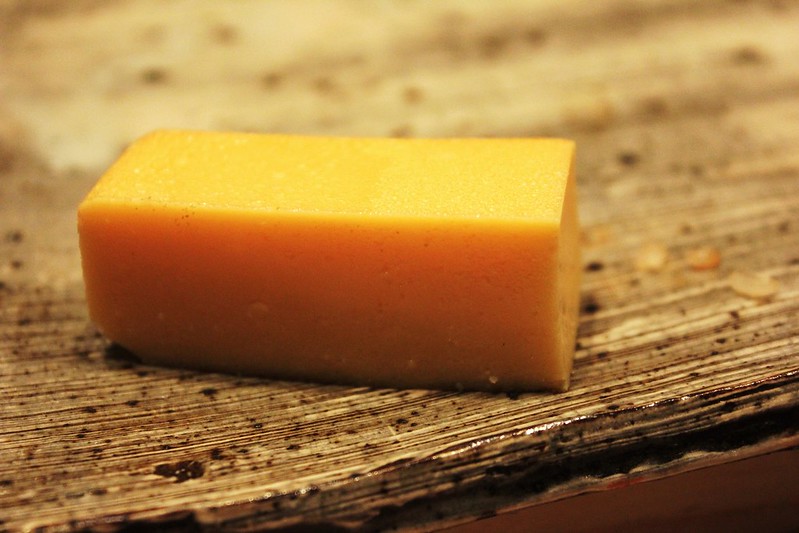
Tamago
Aside from the fish, this was another example of perfect rice. That is, lightly seasoned, and it held together just fine, but when you ate it, you could feel each kernel of the rice gently separate rather than one large clump that would require chewing.
English was somewhat limited, but we were very thankful our chef cared enough to try to describe each item he served (though sometimes with our prodding) and he spoke decent English, certainly far better English than my Japanese. Service was gracious, friendly and polished, and the fact that we were lucky to sit next to a very friendly couple from Hong Kong did nothing to diminish the experience.
My only complaint, as I noted above, is that this was an extraordinarily expensive meal (just over $300, including sake) in which the focus is so largely on the quality of the ingredients rather than creativity. I'm not saying that's a bad thing, and I suppose when you start to enter into the hundreds of dollars for a meal, it's less objective satisfaction and more subjective enjoyment. And ultimately, this was the very best sushi meal I've ever enjoyed, and I certainly paid for that privilege. If you find yourself in Tokyo, Kanesaka is definitely worth a visit. You should also know that it's basement level, not easily seen from the street. And despite having a phone with Google Maps, I still asked a police officer for help when we came to the right point on the map, just to make sure that we were in fact at the right place.
-
-
Post #29 - October 16th, 2013, 3:49 amEpic posts and trip BR.
Excellent photos as well, thanks for sharing.
-
-
Post #30 - October 16th, 2013, 6:04 amGreat pictures and posts, BR. Tell me more about the fugu. Did you get buzzed at all from eating it? Mouth numb? Extra limbs growing from your torso? Anything like that?Steve Z.
“Only the pure in heart can make a good soup.”
― Ludwig van Beethoven

